Israel
![]()
The title of this article is ambiguous. For other meanings, see Israel (disambiguation).
Template:Infobox State/Maintenance/NAME-German
Israel (Hebrew ישראל Jisra'el), in long form State of Israel (Hebrew ![]() Medinat Jisra'el), is a state in the Near East on the east coast of the Mediterranean Sea. Israel is the only state in the world with a majority Jewish population and, according to its own self-image, is the nation-state of the Jewish people. Geographically, Israel belongs to the Mashreq and borders Lebanon, Syria, Jordan, Egypt as well as the Gaza Strip and the West Bank. The capital and most populous city of Israel is Jerusalem; however, the United Nations and the majority of its member states do not recognize Jerusalem as Israel's capital. The largest metropolitan area is Gush Dan around the Mediterranean metropolis of Tel Aviv-Jaffa.
Medinat Jisra'el), is a state in the Near East on the east coast of the Mediterranean Sea. Israel is the only state in the world with a majority Jewish population and, according to its own self-image, is the nation-state of the Jewish people. Geographically, Israel belongs to the Mashreq and borders Lebanon, Syria, Jordan, Egypt as well as the Gaza Strip and the West Bank. The capital and most populous city of Israel is Jerusalem; however, the United Nations and the majority of its member states do not recognize Jerusalem as Israel's capital. The largest metropolitan area is Gush Dan around the Mediterranean metropolis of Tel Aviv-Jaffa.
The territory of modern Israel is considered the cradle of Judaism and later of the two younger Abrahamic religions. Since 63 B.C., it has been under successive Roman, Byzantine, Arab, Ottoman and British rule. The Jews (biblically: Israelites, Hebrews) who had lived there for about 3,000 years were expelled several times in the course of history or forced to emigrate (Jewish diaspora). From the end of the 19th century, there were efforts among European Jews, not least because of the increasing persecution of Jews in Europe, to re-establish a Jewish state in the then Ottoman Palestine (Zionism, named after Zion, the Temple Mount). A first foundation stone for this was laid at the first Zionist Congress (1897 in Basel) under the leadership of Theodor Herzl; the plan to found a state took on more concrete form with the British Balfour Declaration of 1917. From 1920 to 1948, the League of Nations mandate for Palestine existed, which had been transferred to Great Britain after the dissolution of the Ottoman Empire. Increased Jewish immigration and the establishment of proto-state structures led to the first conflicts with the Arab population during this period. The UN partition plan for Palestine of 1947 aimed to resolve these, but it was rejected by the Arab side. Nevertheless, the Israeli declaration of independence took place on May 14, 1948, and immediately afterwards the first Palestinian war began due to the military attack of the neighboring Arab states on the young state. The following decades of Israel's history were decisively shaped by the ongoing Arab-Israeli conflict.
Israel's political system is based on a parliamentary system of government. The head of government is the prime minister, who is appointed by the Knesset; the head of state is the president, who fulfills mainly representative duties. Israel is constituted as a liberal democratic constitutional state with a pronounced welfare state; the country is often referred to as the "only democracy in the Middle East." The predominantly centrally administered Israeli state is divided into six districts, and these in turn are subdivided into 71 cities, 141 municipalities and 53 regional associations (mergers of smaller localities into administrative communities).
The densely populated country has a population of about 9 million in 2019, including about 6.7 million Jews (74.2%), 1.9 million non-Jewish Arabs (20.9%), and some other minorities traditionally resident in the country, such as Christian Arameans, Samaritans, Armenians, Circassians, and Roma. The Law of Return allows all Jews of the world to settle in Israel. Since about 1990, there have also been increasing numbers of legal Asian and Eastern European labor migrants, as well as illegal immigrants from Africa, living in the country.
The Jewish population is composed of Ashkenazim, Mizrachim, Sephardim, Falashim and Yemenite Jews, but an increasing merging of these groups can be observed. The majority of Arab Israelis are Muslims, with Arab Christians and Druze forming a minority.
Despite adverse external circumstances (exposed geographic location, wars with neighboring Arab states, lack of water and raw materials, dependence on foreign capital), Israel has succeeded in developing a highly developed economic and scientific sector. The Israeli economy is characterized by advanced agriculture and specialized, highly export-oriented industry. Important industrial sectors include diamond processing, the chemical and pharmaceutical industries, and semiconductor technology; in the service sector, the financial industry, software development, and tourism are particularly noteworthy. The high-tech industry is of growing importance; the country has the highest spending on research and development per inhabitant and the highest density of start-ups worldwide.
However, the high level of social inequality is pronounced, mainly due to the insufficient economic integration of the Arab and ultra-Orthodox segments of the population. The country has been a member of the Organization for Economic Cooperation and Development (OECD) since 2010. According to the Human Development Index (HDI), Israel is ranked 22nd (1st in the Middle East, 4th in Asia, as of 2017), making it one of the very highly developed economies.
Name
The oldest evidence for the designation "Israel" is contained in the Egyptian Merenptah Stele, which is now in the Egyptian Museum in Cairo. It describes a campaign of Pharaoh against Israel in the land of Canaan and is dated to the year 1211 BC. The Bible tells of the "children of Israel," equated with the "Hebrews" it also mentions, and the kingdoms of Israel and Judah, which until the conquest by Assyria (destruction of Israel in 722 B.C.) and the Babylonian exile of the king of Judah and his people (from 597 B.C.), respectively, formed two small states that were involved in numerous political alliances and conflicts with their neighbors and fought each other. The ruling dynasty of Judah derived from the all-Israelite King David (10th century BC).
The folk etymology of the Old Testament interprets "Israel" as "God's fighter" (Gen 32:29 EU). Jacob received this epithet after he wrestled with a mysterious adversary. His descendants, the twelve tribes, were called "Children of Israel," "Israelites," or "Israel" for short. The name corresponds to a widely used Semitic form of name that includes a verb in the imperfect tense and the theophore element El as the subject. The verbal element is considered in this interpretation to be derived from the Semitic root שרה "sarah = to wrestle, to fight." However, a derivation from the root שרר "sarar = to rule" is also possible. The Hebrew imperfect can be rendered in German with the present tense or the desirous form, resulting in the following as possible translations: "God is fighting (for us)" or "God may fight (for us)" and "God rules" or "God may rule".
Derivations from the name Israel are: Israeli, israeli (referring to the present-day state) and Israelite, israelitisch (in the sense of Jew, Jewish, referring in particular to the biblical people of Israel).
Other proposed names before the establishment of the state (1948), but rejected, were: Eretz Israel (Land of Israel), Zion, Judah and New Judah.
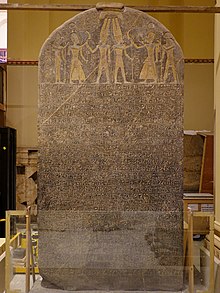
The Egyptian Merenptah Stele - the oldest record of the word "Israel".
Geography
→ Main article: Geography of Israel
Israel is located on a land bridge between Asia and Africa on the eastern edge of the Mediterranean Sea. Thus it belongs geographically to the Near East, but geologically to Africa, since it lies on the African continental plate. To the east lies the Arabian Plate and the border to it is formed by the Jordan Valley, which is part of the Great AfricanRift Valley. Israel borders Lebanon to the north, Syria to the northeast, Jordan to the east, Gaza and Egypt to the southwest, and the Red Sea to the south.
Area
The area of Israel within the so-called Green Line, the armistice line of 1949, is 20,991 km², of which 20,551 km² is land and 440 km² is water. This is approximately the size of Hesse. As a result of the Jerusalem Law in 1980 and the annexation of the Golan Heights in 1981, Israel has an area of 22,380 km² from the Israeli point of view, which is about twice the size of Lebanon. In length, the country measures 470 km from north to south. At its widest point, the country measures 135 km, at its narrowest only 15 km.
The territories conquered by Israel in the Six-Day War of 1967 have an area of over 67,000 km², of which about 60,000 km² are accounted for by the Sinai Peninsula, which was returned to Egypt in 1982. The area of the Golan annexed by Israel is 1150 km², and that of East Jerusalem and its surroundings is 70 km². The West Bank, historically and in Israel officially called Judea and Samaria, covers 5879 km², 220 km² of which is water, and the Gaza Strip measures 360 km².
In the course of the First Lebanon War in 1982, Israel briefly occupied about 6500 km² of Lebanon and advanced as far as Beirut, but then withdrew again as far as southern Lebanon, occupying an area of 3058 km² until 1985. The security zone established thereafter south of the Litani River was vacated in May 2000.
Landscape
Israel can be divided into four regions: The Mediterranean coast, the hill country in the center, the Jordan Valley and the Negev Desert.
The Dead Sea is with 418 m under the sea level the lowest point of Israel and the earth, the highest point of the country is the mountain Meron in Galilee with 1208 m, or from Israeli view a 2248 m high pre-summit of the Hermon.
The coastal plain runs from the Lebanese border to Gaza in the south, interrupted only by the Carmel Cape in Haifa Bay. Around Gaza it is about 40 kilometers wide, becoming narrower toward the north and only five kilometers wide at the Lebanese border. It is subtropical and is used for growing grapes and citrus fruits. The most densely populated part is the greater Tel Aviv area (Gush Dan). Also very densely populated is the adjacent Sharon Plain to the north. The plain is crossed by several short rivers, only two of which, the Yarkon and the Kishon, carry water year-round.
East of the coast, in the center of the country, a hilly landscape follows. To the north are the mountains and hills of the upper and lower Galilee, and further south, in the politically disputed West Bank, the hills of biblical Samaria with their fertile valleys, which are replaced south of Jerusalem by the Judean hill country with its rather barren hills. The hill country is on average 610 meters above sea level and reaches its highest point in Galilee with Mount Meron (1208 m). Many valleys cut through the landscape in an east-west direction. The largest is the Jezreel Plain (biblically called the Valley of Esdrelon), which stretches 48 km southeast from Haifa to the Jordan Valley. It is 19 km wide at its widest point.
East of the hill country lies the Jordan Valley, which forms a short section of the 6500 km long Great African Rift Valley. The Jordan River, Israel's longest river at 322 km, is fed from the Dan, Banijas and Hasbani headwaters in the north. The Jordan River flows south through the Chula Plain into the Sea of Galilee (Hebrew ים כנרת Jam Kinneret). The lake has an area of 165 km² and is located at about 213 m below sea level. With a storage capacity of three cubic kilometers, it is the main water reservoir of the National Water Carrier. The Jordan River drains to the south of the Sea of Galilee and eventually ends in the Dead Sea, which is an extremely saline lake with no outlet. The Dead Sea, which Israel shares with the Palestinian territories and Jordan, is the lowest point on the earth's surface. It lies 418 m below sea level and has an area of 1020 km². South of the Dead Sea, the Rift Valley leads to the Gulf of Aqaba with the Arava Depression, which has no permanent water flow for 170 km. The Arava depression forms the border with Jordan.
With an area of about 12,000 km², the Negev covers more than half of Israel's land area. Geographically, it belongs to the Sinai Desert. The desert region begins in the north at about the level of Be'er Sheva and ends at Eilat, the southernmost city in Israel.
Rivers and seas
Israel borders on two seas: the Mediterranean Sea to the west and the Red Sea to the south. Haifa, Ashdod and Eilat have partly large ports, which are an important part of the Israeli economy. The most important water sources in Israel are the headwaters of the Jordan River: the Hasbani, the Dan in northern Israel and the Banyas (also called the Hermon River) in the northern Golan Heights rise in the area around the Hermon Mountains. They join in the area around Sede Nehemiah to form the Jordan River, which then crosses the Hule Plain of northern Galilee in a north-south direction before flowing into the Sea of Galilee at Bethsaida. South of the lake it enters the Jordan Rift Valley and in its further course takes in on the left the only two major tributaries, Yarmuk and Jabbok. Southeast of Jericho, it empties into the Dead Sea, an outletless terminal lake.
In its almost entire southern course (except for the stretch from the Sea of Galilee to Bet She'an), the Jordan River forms the border between Israel and Jordan. In the northern section, it flows along the Israeli Golan Heights.
The Jordan Rift Valley with the Dead Sea forms a geological depression and, as a rift valley, is highly prone to earthquakes.
Climate
The climate in Israel is determined by its location between the subtropical aridity of the Sahara and the Arabian deserts on the one hand, and the subtropical humidity of the Levant on the other. Although Israel is a rather small country, it has several climatic zones. The climate depends on the distance from the Mediterranean Sea, altitude and latitude. Temperate and forested in the north, Israel is hot and desert in the south. In total, 50% of the country is steppe and desert, with the Negev Desert being the largest area. On the coast facing the Mediterranean Sea, the subtropical Mediterranean climate prevails, characterized by dry, hot summers and rainy, mild winters.
January is the coldest month, with average temperatures between 6 °C and 15 °C; July and August are the warmest months, with temperatures ranging from 22 °C to 33 °C. Summers are characterized by high humidity on the Mediterranean coast, but quite dry in the interior of the country, the Jordan Valley and the Negev. The highest temperatures are often reached in Eilat, locally up to 46 °C. More than 70% of the average rain falls between November and March. From June to September there is usually no rain. Rainfall decreases sharply from north to south, so that in the very south an average of only 30 mm can be expected, in the north more than 900 mm per year. Especially in the Negev, the amount of precipitation varies greatly from year to year. In winter, snow can fall in the higher regions, and occasionally in Jerusalem. The three peaks of Hermon are covered by snow for several months in winter.
The areas with rainfall of more than 300 mm per year are used particularly intensively for agriculture. About one third of the land can be cultivated.
During the rainy season, thunderstorms and hail are also possible, and waterspouts can hit the Mediterranean coast but cause very little damage. However, on April 4, 2006, the western Galilee was hit by thunderstorm cells and an F2 tornado that caused major damage and injured 75 people.
· 
Be'er Sheva climate chart
· 
Eilat climate chart
· 
Haifa climate diagram
· 
Tel Aviv climate chart
Cities and towns
→ Main article: List of cities in Israel
There are 68 cities and hundreds of smaller towns in Israel. City status is granted by the Israeli Minister of the Interior to localities that apply, usually only if they have more than 20,000 inhabitants.
Larger cities are Jerusalem (901,302 inhabitants), Tel Aviv-Jaffa (443,939 inhabitants), Haifa (281,087 inhabitants), Rischon LeZion (249,860 inhabitants), Ashdod (222,883 inhabitants) and Be'er Sheva (207,551 inhabitants). In Jerusalem, Haifa, Jaffa or Akko and Ramla, the Arab and Jewish populations live together to some extent. The largest predominantly Arab city is Nazareth (76,551 inhabitants), followed by Umm al-Fahm (54,240 inhabitants); the largest city inhabited by Bedouins is Rahat in the Negev (66,791 inhabitants).
A special Israeli feature is the kibbutzim and moshavim. These are localities with a socialist-collective or cooperative constitution. Over time, however, the degree of cooperative cooperation has declined, and locally it has been abolished altogether.
In the occupied territories of the West Bank, there are just over 200 Israeli settlements, four of which are towns with populations over 15,000, and about 145 unauthorized so-called "outposts. "There are 32 Jewish settlements in East Jerusalem and 42 in the Golan Heights (2010 estimate).
Israeli settlements in the territories conquered by Israel in June 1967, including those annexed by Israel, are considered by various international organizations to be illegal settlements under current international law, which prohibits population transfers to occupied territories (IV Geneva Convention, Article 49). However, Israel denies that these are territories where the IV Geneva Convention applies.
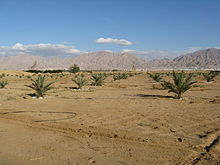
Date palms in the Arava
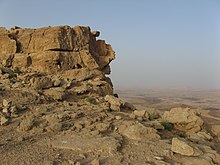
Erosion crater Machtesch Ramon in the Negev

The Banyas, one of the headwaters of the Jordan River
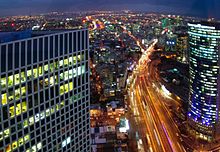
Night view of Tel Aviv-Jaffa, second largest city in Israel and economic metropolis

Haifa Port
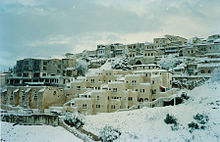
Safed in winter

The Dead Sea
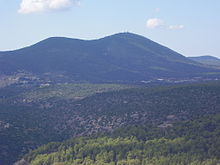
Har Meron in Galilee

Sea of Galilee
Flora and fauna
→ Main article: Flora and fauna of Israel
Flora
Due to the different climatic conditions in the various parts of the country, Israel has a wide variety of landscapes. Thereby, the flora of Israel ranges from the fertile vegetation in parts of the north to some oases in the south.
Olive trees, oaks, fig trees and carob trees have always grown in Israel. Since the 1950s, Israel has begun planting coniferous forests, mainly Aleppo pine and Mediterranean cypress, and orchards. In total, more than 240 million trees have been planted so far. Today, about 3% of Israel's land (213,000 hectares) is forested.
In Israel grow wild about 125 species of plants, which are also cultivated and grown as ornamental plants, including crown anemone, sun-eyed tulip, bouquet daffodil and Madonna lily. However, it is considered unlikely that these garden plants were domesticated here. The cactus Opuntia ficus-indica, introduced from America, grows in the Negev Desert. In the south of the country, there are also artificially planted acacias and chestnuts since about 1985. Date palms grow in the coastal areas and in parts of the Negev.
There are numerous protected areas in Israel, with 63 (as of 2008) developed for tourism, managed and maintained by the Israel Nature and Parks Authority (INPA) as Israeli national parks and nature reserves.
Fauna
Due to the different climatic conditions and different landscapes, Israel also has a very diverse fauna. However, numerous animals are threatened with extinction, and in the early to mid-20th century the northeastern Nile crocodile (Crocodylus niloticus niloticus) already died. In the early to mid-20th century, the Northeastern Nile Crocodile (Crocodylus niloticus niloticus), the Syrian Brown Bear (Ursus arctos syriacus), the Asiatic Cheetah (Acinonyx jubatus venaticus), the Syrian Half-Ass (Equus hemionus hemippus), the Arabian Ostrich (Struthio camelus syriacus) and the Arabian Goiter Gazelle (Gazella subguttorosa marica) already became extinct in Israel. The Asiatic lion (Panthera leo persica) and the Caucasian red deer (Cervus elaphus maral) became extinct in Israel in the Early Middle Ages, and the hippopotamus in the Iron Age. Some specimens of the rare Arabian leopard (Panthera pardus nimr) still exist in the Judean Desert and the Negev. Among the large animals, the Syrian ibex, for example, has managed to survive.
In the desert areas of the Avara and the Negev, Arabian oryx antelopes and Persian half-ass (Equus hemionus onager) have been reintroduced and are bred in the Chai Bar Jotvata Game Park. In the north, there is a similar game park, Chai Bar Karmel, where the species of Mediterranean climates such as Armenian wild sheep (Ovis orientalis gmelini) and Mesopotamian fallow deer (Dama dama mesopotamica) are bred. The latter are also called Persian fallow deer and are also found again in the wild in northern Israel. The roe deer (Capreolus capreolus coxi) was also reintroduced.
Pink flamingos (Phoenicopterus roseus) live near salt ponds near Eilat. The Syrian striped hyena (Hyaena hyaena syriaca), the Arabian wolf (Canis lupus arabs), the two subspecies of the Edmiga gazelle, Palestine mountain gazelle (Gazella gazella) and Acacia gazelle (Gazella gazella acaciae), the Dorkas gazelle (Gazella dorcas) and the wild boar (Sus scrofa) are other animals living in Israel.
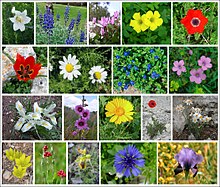
Example image of the flora of Israel

Mesopotamian fallow deer in wild park Chai Bar Karmel
Population
→ Main article: Demography of Israel
General demographics
At the end of 2020, Israel had a population of 9,291,000, about 6,870,000 (73.9%) of them Jews and 1,956,000 (21.1%) Arabs. The number of other residents was about 456,000 (5.0%).
In terms of population, Israel ranks 99th among all countries in 2018, just after Austria and ahead of Switzerland.
About 92 % of the population lives in urban areas, 25 % in one of the large cities. About 75% of Jewish residents were born in the country, 28% are younger than 14 and 10.3% are older than 65. The average age in 2017 was 29.5 years. The population density is 373.2 persons per sq. km. In 2018, life expectancy was 80.6 years for men and 84.2 years for women, making it the eighth highest in the world.
Citizenship can be obtained in several ways: First, by descent, and second, by naturalization or residence. This territorial principle was applied to those residents of Palestine who lived in the territory of Israel after 1948. Naturalization is also possible through the granting of citizenship. Through the Law of Return, all Jews who immigrate to Israel can, in principle, obtain Israeli citizenship, with dual citizenship possible. Non-Jewish residents of the territories conquered by Israel in the 1967 Six-Day War (East Jerusalem and the Golan Heights) can become naturalized citizens.
Population growth
After the establishment of the State of Israel in 1948, about 806,000 people lived in the Israeli territory. In the following years, the population increased sharply. This increase was due to the immigration of Jews from Europe and some Arab states.
The total population of Israel never decreased throughout the history of the state. Despite the Middle East conflict and the Arab-Israeli wars, the population continues to grow. Only as a result of the Yom Kippur War did over 130,000 Israelis emigrate from Israel. However, this population loss was made up for by the high birth rate of Jewish families. After the collapse of the Soviet Union, over 700,000 Soviet Jews came to Israel, which represented a population increase of over 20%. Beginning in 1996, population growth began to slow as the government pursued tighter fiscal and monetary policies. Since the 2000s, the population has been growing strongly again. Population growth is driven primarily by high birth rates among the ultra-Orthodox and Muslim populations. Both groups together accounted for over 40% of newborns in 2015.
Current population growth is about 1.8 percent per year, exceeding the percentage population growth of India and the People's Republic of China.
| Population of Israel since 1948 | |||||||||||||||||||||||||||||||||||||
|
| ||||||||||||||||||||||||||||||||||||
Spatial distribution
Population density
Israel has a population density of about 381 inhabitants per square kilometer. However, population density is unevenly distributed. Areas that are hostile to life, such as the Negev Desert, have a low population density; the Golan Heights are also rather sparsely populated. In Arava, the most sparsely populated part of the country, an average of only 20 to 30 people live per square kilometer.
By far the largest part of the population lives in the large cities such as Tel Aviv-Jaffa, Rishon LeZion and Haifa on the coastal regions in the west of the country. With over 3,000 people per square kilometer, these are the most densely populated places. Other densely populated places include Jerusalem and the surrounding areas of the city. Israel is the 33rd most densely populated country in the world and the most densely populated state in the Middle East.
Urbanization
When the state was founded in 1948, about only 30 percent of the population lived in cities, with a large difference between Arabs and Jews; about 75 percent of Israeli Jews lived in cities at that time. In 2013, according to the Israeli government, the urbanization rate has reached over 78 percent. This means that the degree of urbanization is much higher compared to other industrialized countries. This is mainly due to the fact that cities were almost the only habitable living space in Israel until the 1960s. In addition, until the Six-Day War of 1967, there were repeated Arab terrorist attacks on Jewish settlements in the borderlands, in which numerous people died and many families fled. Enabled by the settlement of hostile zones of the national territory, Israel's degree of urbanization has been declining again since the mid-1980s.
Populations
→ Main article: Israelis
Israeli statistics distinguish between "Jews" and "Arabs," to which another, "different" group has been added since 1995.
Jewish population
At the end of 2020, 73.9% of Israelis were Jewish. Among Israel's Jewish population in 2001, 26% had at least one parent born in Israel, 37% were first-generation Israelis, 34.8% were immigrants and their direct descendants from Europe and North America, and 25.3% were immigrants and their descendants from Asia or Africa, mainly from Muslim countries. After the collapse of the Soviet Union, more than one million Jews immigrated to Israel from its successor states, including more than 750,000 in the period from 1989 to 1999 alone.
Within the Jewish population a distinction is made between
- Ashkenazim, Jews with roots in Eastern and Central Europe, former states of the USSR, as well as European-origin Jews from the USA, Argentina and other Western states, as well as their descendants.
- Sephardim, Jews whose ancestors came from the Iberian Peninsula
- Mizrachim, Jews from the Near East and North Africa and their descendants.
- Falashen, immigrants from Ethiopia who were flown to Israel mainly through military operations Moses (1984), Joshua (1985), Solomon (1991), and Dove's Wing (2011)
- Yemeni Jews, immigrants from Yemen who were flown to Israel between 1949 and 1950 through the military Operation Magic Carpet.
Arab population
→ Main article: Arab Israelis
21.1% of the Israeli population is Arab. Some of the Arab population lives in mixed Arab-Jewish towns such as Haifa, Jerusalem, Acre and Ramle. The larger part lives in Arab towns in the Galilee, in the eastern part of the coastal plain bordering the West Bank between Tel Aviv and Haifa, and in the northern part of the Negev. 10% are Bedouin, many with permanent residences, and another 10% are Druze, whose villages are located in the Galilee, Mount Carmel, and the Golan.
Other
The population of (456,000 inhabitants at the end of 2020), referred to as "Others," includes non-Jewish immigrants, the Bahai, who call themselves not only a separate religious community but also a separate population group, the Alawites, the Ahmadi, the Samaritans and two villages of Circassians. Since September 2014, Arameans have also been recognized as a distinct national population group. Since the 2000s, Israel has also been home to several thousand Asian guest workers and illegal immigrants from Africa. There is also a small minority of European Christians in Israel, consisting mainly of Russians, Ukrainians and Poles.
Israelis in the occupied territories
→ Main article: Israeli settlement
Israelis in the occupied territories live predominantly in Judea and Samaria (West Bank). A large number of Israelis live in the Golan Heights and East Jerusalem, which were annexed in 1981, far exceeding the Arab population.
Emigration
For several years, there has been no more accurate data dealing with Israeli emigration.
In recent decades, emigration from Israel had increased significantly. By 1990, eight percent of Israel's Jewish population had emigrated. From 1990 to 2005, 230,000 Israelis emigrated. Most had previously immigrated to Israel. By 2005, 15 percent immigrated again. In 2007, 21,500 Israelis emigrated; this was the last major wave of emigration from Israel. Since 2008, emigration levels have been declining, and 73 percent of emigrated Jews and 4 percent of Arabs returned to Israel by 2013.
According to the Israeli Central Bureau of Statistics, 650,000 emigrated Israelis live abroad today worldwide.
Religions
→ Main article: Religions in Israel
The State of Israel's 1948 Declaration of Independence guarantees freedom of religion. The religious communities administer their religious and holy sites themselves; legal regulations are intended to guarantee free access and protect against desecration. Recognized religious communities include the Jewish, Islamic, and various Christian congregations, as well as those of the Druze and Bahai. The state-recognized religious communities have a right to internal autonomy and to state funding for their houses of worship and the salaries of religious officials.
A good 75% of Israel's population are Jews. This makes Israel the only state in the world in which Jews form the majority of the inhabitants. According to a survey conducted in 2009
- 46% as secular,
- 32% as traditional,
- 15% as Orthodox and
- 7% as ultra-Orthodox Jews (Charedim).
According to a 2015 study, 65 percent of Israelis declared themselves non-religious or atheists. Only 30 percent declared themselves to be religious.
The majority of Israeli Arabs are Sunni Muslims. In 2001, there were 1,004,600, about 17% of the population. At the end of 2019, there were 177,000 Christians living in Israel, or 2.0% of the population. About 137,000 (77.5%) of them are Arab Christians, and about 40,000 (22.5%) are non-Arab Christians. 143,000 Israelis are Druze (as of 2019). This corresponds to 1.6% of the population.
The world's only congregation of Samaritans numbers 751 people (end of 2011). A good half live in Israel, the rest live in the West Bank.
There are about 25,000 Karaites living in Israel, as well as an unknown number of Messianic Jews, who have retained certain elements of the Jewish religion but consider Jesus of Nazareth to be the Messiah and are thus counted as part of Christianity.
Finally, several hundred Bahai live in Haifa and the surrounding area, where their central sanctuaries are located, forming the Bahai World Center. It has been a UNESCO World Heritage Site since 2008.
Languages
→ Main article: Languages in Israel
According to the 2018 National State Law, Hebrew is the only official language; previously, Hebrew and Arabic were both official languages, although Hebrew was in fact the preferred official language. Arabic is now assigned a "separate status," although the law equally declares that the previous status of Arabic is to be maintained and that the use of Arabic by state institutions will be regulated by individual laws.
During the British Mandate period between 1922 and 1948, both English and Arabic were official languages alongside Hebrew, with English taking precedence over the other two. After independence, the relevant clause was repealed and English was no longer actively used as an official language (except for certain niches, such as warning signs), but remained in use "passively," so to speak, mainly because many government documents were only available in that language. Bilingual signs are more often inscribed in Hebrew and English than in Hebrew and Arabic, and public announcements often appear in English as well. In addition, as is now the case almost everywhere in the world, English plays an important role in science, business, and international communication, but it is considered a foreign language, and government publications appear in that language only when they address international audiences. English is the primary foreign language in schools, and most Israelis are familiar with the language through this and through consumption of American media.
The Hebrew language, revived at the end of the 19th century, is spoken by the majority of Israelis. Arabic is also the mother tongue of more than one million Arab and Druze citizens, as well as of most Jewish immigrants who arrived from Arab countries in the 1950s/1960s. In Arab schools in Israel, Arabic is the school language. In Hebrew schools, Arabic is compulsory as a second foreign language along with English.
In official correspondence, Hebrew is used almost exclusively; official forms are usually available only in Hebrew, and Israeli passports are in Hebrew and English. In the Israeli school-leaving examination (Bagrut), all students must demonstrate a knowledge of Hebrew.
Standard of living
Human Development Index
In the ranking of the Human Development Index published by the United Nations Development Programme, Israel ranked 22nd out of 188 countries evaluated in 2017, with a score of 0.903. In 2016 and 2015, Israel ranked 19th out of 188 countries evaluated, with scores of 0.899 and 0.898, respectively.
In 1990, the state ranked 15th with a score of 0.785; in 2000, it ranked 17th with a score of 0.850; and in 2010, it ranked 26th with a score of 0.833.
Health
In the Bloomberg index of the healthiest countries 2019, Israel is in tenth place. By comparison, Austria came in 13th, Germany 23rd and the USA 35th. The authors of the study commissioned by Bloomberg L.P. based their assessment on criteria such as life expectancy, drinking water supply and healthcare. Tobacco consumption and obesity were rated negatively.
Life expectancy in Israel is among the highest in the world and in 2018 was 82.7 years, 84.7 years for women and 80.8 years for men. The fertility rate of 2.66 in Israel is the highest among developed countries.
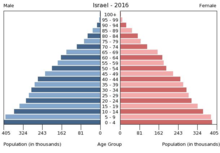
Population pyramid of Israel 2016: Israel's population is very young.
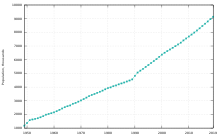
Population development of Israel since 1949
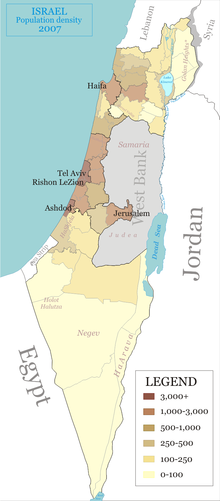
Population density of Israel 2008

Arab minority in Israel (2000)

The Wailing Wall with the Temple Mount and Dome of the Rock in East Jerusalem
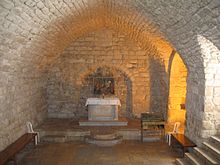
Nazareth, Synagogue Church

Bahai gardens in Haifa
History
→ Main article: History of Israel and History of the State of Israel
Previous story
→ Main article: Prehistory of Palestine
Prehistory extends from the oldest human traces to the beginning of a broader written tradition. Some representatives of Homo erectus left Africa about two million years ago. The oldest traces in Israel, which are considered to be secure, could be dated to 1.4 million years ago and were discovered south of the Sea of Galilee in Israeli and Jordanian territory. Another wave of migration followed about 600,000 years ago. At least 250,000 years ago Neanderthals (stone working techniques assigned to them could be proved) appeared in the region and others possibly came from Europe in cold times, living here at the same time as the archaic Homo sapiens. Considered the direct ancestor of modern humans, it evolved in East Africa at least 200,000 years ago and can be traced to Palestine 110,000 years ago. Some of these anatomically modern humans may have left Africa about 130,000 years ago. But they disappeared again from Israel 80,000 years ago, only to reappear there 50,000 years ago. Once again they lived with Neanderthals in the same region, probably sharing descendants. Between 45,000 and 28,000 years ago, Neanderthals disappeared. In the Jordan Valley, a 200 km long, 2000 km² lake was formed 70,000 years ago and existed until 12,000 BC. People continued to live from big game hunting, smaller animals and fishing also played an increasingly important role, and gathering activities continued.
As early as 18,000 B.C., there are increasing signs of more permanent camps - a village-like structure is attested - limited production of food, and wild barley was ground and baked. The main hunting game was gazelles, and camps were established along their migration routes. Around 12,000 B.C., houses made of semicircular stone settlements with superstructures of clay appeared, and cereals were planted by 11,000 B.C. at the latest. Signs of rituals and sacrifices increased, the dead were usually buried in a contracted position, occasionally the skulls were buried separately. The art, which until then had been quite abstract, was supplemented by more realistic depictions, which are considered to be the oldest pictorial documents of the Near East.
In the epoch between 9500 and 8800 BC agriculture was practiced, but the production of clay vessels was not yet known. The most important site is Jericho, which stands out among the settlements, most of which were less than half a hectare in size, with an area of 4 hectares. Around 8000 BC, a wall 3 m high surrounded the city, which housed perhaps 3000 people, but from 7700 to 7220 BC the city was uninhabited. From 8300 B.C. onward, grain production, which until then had been limited to the Jordan Valley and the Golan Heights, continued to spread, and around 7600 B.C. there was a major expansion of the settlement area, accompanied by migratory movements or greater population growth. Most of the older settlements were abandoned.
Jericho re-emerged around 7220 and was inhabited until 6400 BC. The migration patterns of the epochs before the "mega-villages" were resumed around 7000, besides fixed settlements continued to exist. It was only after this phase that stabilization occurred, providing the conditions for urban structures, and ceramics also came into use. Sha'ar HaGolan, a site of 20 ha in area, may have been the largest city between 6400 and 6000 BC. Long-distance trade can be attested as far as Anatolia and the Nile, perhaps migrations took place there. Between about 5500 and 4500 BC there were no contacts with Egypt, probably due to climatic deterioration. Between 4400 and 4000 BC, livestock and the type of agriculture there again point to Palestinian origins. In the Copper Age, Teleilat Ghassul in the Jordan Valley was one of the largest settlements, covering an area of 20 ha. It contained spacious houses 3.5 by 12 meters in area, as well as a temple. Between 3500 and 3300 B.C. there was a drastic cultural collapse, but no traces of violence have been found.
After that, a Bronze Age epoch called "early urban" began, which maintained trade relations far beyond Palestine, especially with Egypt. Egyptians can be documented along the trade routes to Palestine in a settlement network. Egypt, now centralized under a pharaoh, sought to gain control, sometimes by force, over raw materials between the Sinai and Lebanon, which were of great importance for the enormous building activity associated with the pyramids there. Closely related to these battles may be the existence of numerous fortified settlements. More than 260 settlements with a total population of perhaps 150,000 are known from this period in western Palestine alone, mainly in Galilee, Samaria and Judah. Among them, Beth Yerah and Yarmuth were the largest with 20 and 16 ha respectively, some cities had city walls up to 8 m thick, Beth Yerah had perhaps 4000 to 5000 inhabitants. City gates and large temple complexes like those at Megiddo were built. At the end of the Early Bronze Age, urban culture collapsed and pastoralism became dominant. At the same time, "Asiatics" repeatedly attacked the Nile Delta until the Semitic Hyksos took over there after 1700 BC.
Development since the appearance of the Israelites in Canaan until the 19th century
→ Main article: Roman Palestine
The first archaeologically proven traces of an early or proto-Israelite settlement in the Mashreq region date back to the period between the 12th and 11th centuries BC (cf. Land Grabbing of the Israelites). According to biblical tradition, Jerusalem was conquered by David from the Jebusites in about 1000 B.C. and chosen as the capital of his great empire; this fell into two kingdoms after the death of Solomon, the heir to the throne. The northern kingdom of Israel perished in 722 B.C. in battle against the Assyrians, and the southern kingdom of Judah was conquered by Babylon in 587 B.C.. The country subsequently became part of the Persian Empire, then of the empire of Alexander the Great, and finally of the Seleucid Empire.
The uprising of the Maccabees in 165 BC brought Israel state independence once again for about 100 years. In 63 BC, the period of Roman suzerainty began. The Romans divided the territory into two provinces: Syria in the north, Judea in the south. In the Jewish War, Jerusalem and the Jerusalem Temple were completely destroyed in 70 AD. The last Jewish revolt in Israel against Roman rule (Bar Kochba revolt) was put down in 135 AD. Part of the Jewish population was expelled. The land itself has been called "Palestine" ever since. This name, which goes back to the Philistine people, who had already been absorbed into the neighboring peoples at that time, was given to the country due to a decree by Emperor Hadrian to erase the memory of the Judean inhabitants whose revolt he put down. Nevertheless, Palestine - along with Rome and its provinces in Europe and North Africa, and apart from Mesopotamia (Babylonia) - remained a center of Judaism; until the Middle Ages, both the Babylonian and Palestinian rabbis led the way in the development of the Jewish religion and way of life outside these areas as well.
In the course of the Islamic expansion, the area came under Arab rule in 636. Since that time, Palestine has been inhabited by a majority of Arabs. The Crusaders ruled what they called the "Latin Kingdom of Jerusalem" from 1099 to 1291. They were followed by the Mamluks from 1291 to 1517, and then by Ottoman rule from 1517 to 1918. None of these authorities had provided a separate administration for Palestine or considered the area an independent geographical entity. Even for the Ottomans, the region was a part of Syria, probably going back to the Roman designation Syria. The country was divided into three districts.
See also: Islamic conquest of the Levant
Zionist movement
1880–1917
The beginning or precursor of the Zionist movement is considered to be the Eastern European collective movement Chibbat Zion ("Love of Zion"), which emerged around 1880. Its local chapters were represented in numerous Russian and Romanian cities. Members of Chibbat Zion called themselves Chowewe Zion ("Friends of Zion"). They collected about 3000 emigrants for joint settlement projects in Palestine. During Ottoman rule, Palestine was sparsely populated and economically stagnant. The arrival of the first Jewish immigrants from 1880 onwards gave impetus to the economic development of the country. In the following decades, many more people, Jews and Arabs alike, immigrated to Palestine - partly for this reason.
The first major immigration movement (aliyah) of Jews to Palestine occurred around 1882. In the summer of 1882, a Russian group of six reached Palestine and, with the financial and logistical support of Baron Edmond de Rothschild, established the settlement of Rishon LeZion ("First in Zion"). Between 1880 and 1895, Edmond de Rothschild financed the establishment of more than 30 other colonies in Palestine, including the important moshavot (settlements) of Petach Tikva, Zichron Ja'akow, Rosh Pina, Chadera and Yesod ha-Ma'aleh. Since then, Baron Edmond de Rothschild has been considered the "father of the colonization of Palestine." In 1891, the German-Jewish Zionist Baron Maurice de Hirsch founded the Jewish Colonization Association, which received extensive financial support from Baron de Edmond de Rothschild from 1899. In 1898, according to the Jewish Colonization Association, 5200 Jews were living in Palestine in agricultural model settlements.
Between 1890 and 1914, Cologne was the center of German Zionists and was considered the capital of Zionism for several years. In Cologne in 1893, the two important Zionist functionaries Max I. Bodenheimer and David Wolffsohn founded the Cologne Association for the Promotion of Agriculture and Crafts in Palestine. Bodenheimer also founded the National Jewish Club Zion Cologne, was chairman of the Zionist Association for Germany, and established the Jewish National Fund from his apartment on Cologne's Neumarkt from 1905 to 1914.
However, the key and leading figure of political Zionism became Theodor Herzl. In 1896, during the Dreyfus Affair in France, Herzl wrote the book The Jewish State - Attempt at a Modern Solution to the Jewish Question. In it, Herzl elaborated his idea of a sovereign state organization to give the haphazard and scattered emigration of European Jews a common goal and to secure the Jewish settlement work under international law. Herzl based his idea hardly on religious motives, but on the failure of Jewish emancipation precisely in the civilized countries of Europe. Thus, until then, Herzl had seen France in particular as a haven of social and cultural progress. Now he judged that anti-Semitism would never disappear, that all efforts of the Jews to assimilate would rather strengthen it. Only the gathering of the Jews in their own country could therefore be the way out.
Herzl's book, unlike the writings of his ideological predecessors, was widely read and provided the impetus for the international fusion of the existing national Jewish associations. On August 29, 1897, 200 delegates elected by their associations met in Basel for the first Zionist Congress. There Herzl called for the first time for a Jewish state in Palestine legalized under international law. As a result, the World Zionist Organization (WZO for short) was founded with the maxim: "Zionism strives for the creation of a public-legally secured home in Palestine for the Jewish people." In his diary Herzl wrote: "In Basel I founded the Jewish state... Perhaps in five years, in any case in fifty, everyone will realize it."
In 1901, at the 5th Zionist Congress in Basel, the World Zionist Organization established the Jewish National Fund to provide the first targeted support for Jewish settlement in Palestine. The second aliyah was triggered by pogroms and the failure of the Russian Revolution in 1905. By 1914, some 40,000 mostly young Russian Jews had emigrated to Palestine. There, the Jewish population grew to about 85,000 by 1914. In 1907, at the 8th Zionist Congress, the World Zionist Organization established the Palestine Office in Jaffa, and David Wolffsohn was elected president of the World Zionist Organization. With a loan from the Jewish National Fund, he made possible the construction of the first houses in Ahuzat Bajit, later Tel Aviv, laying the foundation for the first Hebrew city founded in 1909. By 1938, Tel Aviv's population had grown to 150,000.
1917–1948
In the midst of World War I came what was probably the most important chapter in the founding of Israel: on November 2, 1917, on the initiative of the British diplomat Lord Milner, the British Foreign Secretary Arthur Balfour issued by letter the Balfour Declaration, named after him, to the committed British Zionist Walter Rothschild, 2nd Baron Rothschild. According to it, the British government viewed with favor the "establishment of a national home for the Jewish people in Palestine" and would make the "utmost effort to facilitate the attainment of this object." This statement adopted the World Zionist Organization's (WZO) formulation of the goal. This was the first time a European state had recognized the Zionist goal of a Jewish state in Palestine. In doing so, the rights of the resident non-Jewish population were to be preserved.
The British victory in World War I ended Ottoman rule in Palestine in 1917. Following the Sanremo Conference in 1920, the League of Nations gave Britain the Mandate for Palestine in 1922, with the territory now jointly occupied by Israel and Jordan. Among the terms of the mandate was that the British should allow the Balfour Declaration to be implemented, but it should not affect the rights of existing non-Jewish communities in Palestine. The Mandate power was required to allow Jewish immigration, to settle these Jewish immigrants cohesively, and to use former Ottoman state land for this purpose. Express care was to be taken that "nothing shall be done which may prejudice the civil and religious rights of existing non-Jewish communities in Palestine or the rights and political position enjoyed by the Jews in any other country."
In July 1922, the British divided Palestine into two administrative districts, Palestine and Transjordan, which comprised about three-quarters of the Mandate territory. Initially, Transjordan and Palestine were still considered as an administrative unit with uniform Mandate laws, the same currency and the same Mandate passports (see also: White Paper of 1939), but Jews were only allowed to settle west of the Jordan River. In the eastern part, in Transjordan, today's Jordan, the British installed the Hashemite ruler Abdallah, who had been expelled from the Arabian Peninsula.
Baron Edmond de Rothschild founded the Palestine-Jewish Colonization Association (PICA) in 1924 and appointed his son James Armand de Rothschild as director of the organization. The fourth aliyah followed between 1924 and 1932. With the NSDAP's rise to power on January 30, 1933, the nationwide persecution of Jews in Germany began. The first measures of the Nazi regime were the boycott of Jews on April 1 and the Law for the Restoration of the Professional Civil Service and the Law on the Admission to the Bar of April 7, 1933, as a result of which many German Jews lost property, profession and social status. On August 25, 1933, the Ha'avara Agreement between the Jewish Agency, the Zionist Association for Germany and the German Reich Ministry of Economics came into effect to facilitate the emigration of German Jews to Palestine. In the fifth aliyah, 250,000 German Jews emigrated to other countries from 1933 until the start of the war in 1939. From 1933 to 1941, about 55,000 Jews reached Palestine from the German Reich - about a quarter of all Jewish immigrants. Nazi persecution of Jews greatly accelerated the influx of European Jews to Palestine beginning in 1935. Since refugees were still allowed to take up to 1,000 English pounds with them at that time, Palestine experienced an economic boom, which in turn increased the influx of Arabs there. The financial transactions required for emigration from Germany to Palestine were handled 75 percent by the Palästina Treuhandstelle zur Beratung Deutscher Juden GmbH (Paltreu). The Paltreu was founded after the Nazi seizure of power in 1933 by Max M. Warburg, his Hamburg M.M.Warburg-&-CO-Bank, the Berlin banking house A.E. Wassermann and the Anglo-Palestine Bank created by Theodor Herzl.
After the Arab uprising against Palestinian Jews began in 1936, the British refused to implement the Balfour Declaration. Instead, the British Peel Commission presented a first partition plan in July 1937. According to this plan, a large part of Palestine was to be allocated to the Arabs, while the smaller part with the most Jewish settlements was to be allocated to the Jews. Jerusalem and a coastal strip were to remain British Mandate territory. Chaim Weizmann, who headed the WZO since 1935, advocated the adoption of this plan at the 20th Zionist Congress in order to save as many persecuted Jews as possible. The newly immigrated Jews were immediately enthusiastic, but the Arab representatives rejected the plan and demanded that all of Palestine become an Arab state. The plan failed.
In the 1939 White Paper, the British government unilaterally determined that the Balfour Declaration had already been realized. Within the next five years, a maximum of 75,000 Jews were still to be allowed to immigrate to Palestine. At a conference in London in August 1939, British Prime Minister Neville Chamberlain tried to persuade the WCO representatives to renounce a Jewish state in Palestine. Chamberlain's attempts were unsuccessful.
Germany's Orient policy culminated in fraternization with Arab nationalists in a joint struggle against the British and Jews. In 1941, the British-appointed Amin al-Husseini, Mufti of Jerusalem and influential leader of the Arab nationalist movement, was received by Adolf Hitler in Berlin. From Berlin, he is said to have planned with Adolf Eichmann the murder of Jews living in the Arab region.
With the invasion of the Soviet Union on June 22, 1941, the Shoah began with organized mass murders of Soviet Jews and deportations of German and Eastern European Jews to ghettos and camps in Eastern Europe. Between July and October 1941, the most important decisions regarding the expansion of the extermination of Jews were made: the construction of extermination camps now began and German Jews were ordered to wear the Jewish star throughout the Reich. The ongoing Holocaust became known outside Germany in the fall of 1941, but this did not lead to any targeted countermeasures. At the Biltmore Conference convened in New York City in 1942, U.S. delegates to the World Zionist Organization and a group led by David Ben-Gurion, later founder of the State of Israel, called for the first time for "opening the gates of Palestine" to establish there a Jewish commonwealth with a democratic constitution on the European model. This was rejected by the British government, which prohibited the publication of the Biltmore program in Great Britain and Palestine.
Since the Warsaw Ghetto Uprising in January 1943, the number of Jewish refugees grew again. The British government now had Jewish settlements in Palestine searched with increasing frequency, arrested illegal immigrants, and banned Zionist newspapers. In 1944, the underground Zionist organizations Irgun and Lechi expanded their attacks against the British. At the same time, about 100,000 of the 500,000 Palestinian Jews by then were fighting with the Allies in Europe against the Germans. In the final months of the war, the Allies liberated some of the Nazi death camps, including Auschwitz concentration camp on January 27, 1945. No European state except France and Sweden agreed to take in the surviving Jews after the war ended on May 8, 1945. The World Zionist Organization demanded that at least the surviving concentration camp prisoners be allowed to immigrate. U.S. President Harry S. Truman urged the British to admit 100,000 Jewish immigrants immediately, but British Foreign Secretary Ernest Bevin stuck to the low monthly quota. From the Soviet Union, some 175,000 Polish Jews expelled by the Nazi regime had been deported to their homeland since February 1946, but were rejected there by local Poles, many of whom had taken over their property. 95,000 of them then fled to Palestine via Western Europe. The Haganah, the Jewish brigade of the British army, and the Mossad now jointly organized the illegal immigration of Shoa survivors, the so-called Bericha.
The British had 50,000 of them returned to displaced persons camps in the American zone of occupation in Germany in 1945/46; others were interned in Cyprus. During a raid on June 29, 1946, the British army captured all Jewish Agency members and leading Zionists who could be found in Palestine and detained them for weeks in a camp in Lod, about 20 kilometers east of Tel Aviv.
In 1946, attacks by the terrorist underground organization Irgun increased steadily, especially on British railroad lines. Paramilitary task forces of the Haganah, which had by then split from the British, blew up ten bridges on May 16-17. In return for the terrorist attacks, British mandate holders arrested all Zionist leaders on June 29, whereupon on July 22 Irgun, led by Menachem Begin, who later became Israeli prime minister and foreign minister, blew up a side wing of the King David Hotel in Jerusalem, where British headquarters were located. Many people were killed, with casualty figures varying from 91 to 176.
The escalation of unrest continued throughout 1947 - until the United Nations General Assembly voted by a two-thirds majority on November 29 for the UN partition plan for Palestine and the establishment of a Jewish and an Arab state, with Greater Jerusalem to be placed under international control as a corpus separatum. With the UN decision and the beginning of the British withdrawal, Arab riots and attacks now resumed. The day after the UN partition plan was announced on November 30, 1947, the initially guerrilla-like Israeli-Arab civil war, the Palestine War, began. There were raids by Arab irregulars on Jewish settlements and residential areas and counter-attacks by Jewish paramilitary units. Shortly thereafter, the flight and expulsion of the Arab population from the areas now allotted to Israel began, sometimes accompanied by the destruction of their villages, buildings and documents. Often this resulted in the loss of proof of the existence of the Palestinian population and thus of their claim to rights. The Arab population subsequently rejected Israel's right to exist, which has consequences for the region to this day.
See also: History of the Jewish Forces in Palestine
History of the State of Israel
1948: Foundation of the State of Israel
Since the British Mandate for Palestine was to end at midnight on May 14, 1948, a Friday, the Jewish National Council assembled in the house of former Mayor Dizengoff in Tel Aviv at 4 p.m. before sunset and thus before the Sabbath began. Under a portrait of the founder of the Zionist movement, Theodor Herzl, David Ben-Gurion proclaimed the establishment of the State of Israel in the Declaration of Independence "by virtue of the natural and historic right of the Jewish people and by virtue of the decision of the UN General Assembly." Eleven minutes later, the United States of America, through U.S. President Harry S. Truman, recognized the new state, followed by the Soviet Union on May 16 and Czechoslovakia on May 18.
The anniversary of the founding of the state, Yom haAtzma'ut, is celebrated on the 5th of Iyyar according to the Jewish calendar (roughly from April 20 to May 20 according to the Gregorian calendar).
1948: War of Independence
→ Main article: Palestine War
On the very night of its founding, Egypt, Saudi Arabia, Transjordan, Lebanon, Iraq and Syria declared war on the new state. This was followed by the Israeli War of Independence (First Arab-Israeli War), which lasted from May 1948 to January 1949 and brought Israel considerable territorial gains compared to the partition plan - especially in the western Galilee around Akko and in the northern Negev. In 1949, cease-fire agreements were signed with each of the Arab aggressors. Iraq withdrew from the West Bank without such an agreement. The territories intended for the Palestinians according to the partition plan came under Jordanian (West Bank including East Jerusalem) or Egyptian (Gaza Strip) occupation.
During the war, some 850,000 Arabs fled Palestine. Some of these refugees were expelled by Israeli forces, and some were evacuated by Arab forces for strategic reasons. As a result of this dwindling of the Arab population, the majority in the State of Israel since that time has consisted of Jews.
The first election to a constituent assembly, held on January 25, 1949, was won by the socialist-Zionist Mapei party, followed by the left-wing socialist Mapam. David Ben-Gurion became prime minister. The following years saw alternating coalitions of Zionist-Socialist, religious and Arab parties.
After the nationalization of the Suez Canal, which Egypt carried out against existing law, France, Great Britain and Israel decided on the Suez Campaign in 1956. Following an Israeli attack, the two former great powers were to intervene as seemingly neutral forces and occupy the canal area. On October 29, 1956, Israeli troops advanced into Gaza and the Sinai, and European troops began landing on November 5, but the campaign had to end. Under pressure from the United States and the UN, the three invaders withdrew from the occupied territories by March 1957. However, the Israel-Egypt border was subsequently secured by UN peacekeepers, and access to the Gulf of Aqaba was free for Israeli shipping to the Israeli port of Eilat. The United States made a commitment to Israel to keep this international waterway open.
1967: Six Day War
→ Main article: Six-Day War
In 1966, the number of attacks by Arab terrorists had risen to 41, and there were already 37 attacks in the first four months of 1967. Egyptian forces occupied the demilitarized zone of the Sinai on May 15, 1967 (the anniversary of Israel's declaration of independence). They were supported by exiled Palestinian combat units. On May 16, Egyptian President Gamal Abdel Nasser called on UN troops stationed since 1956 to leave the border area with Israel. On May 18, Syrian troops prepared for combat operations on the Golan Heights, and UN Secretary-General Sithu U Thant complied with Nasser's demand without resistance and withdrew UN troops. Radio Cairo reported on May 18: "As of today, there are no more international peacekeepers protecting Israel. Our patience has run out. We will no longer complain to the United Nations about Israel. From now on, total war against Israel prevails, and it will lead to the eradication of Zionism," and from Syria, on May 20, Syrian Defense Minister Hafez Assad said, "Our armed forces are absolutely equipped not only to repel aggression, but also to launch a liberation strike and blast the Zionist presence out of our Arab homeland. The Syrian army, finger on the trigger, is united ... as a military, I firmly believe that the time has come to enter into a battle of annihilation."
On May 22, the Egyptian army again closed the Strait of Tiran (the entrance to the Gulf of Aqaba) to Israeli shipping. On May 30, Jordan also concluded a military pact with Egypt. Nasser then announced, "The armies of Egypt, Jordan, Syria and Lebanon have marched on Israel's borders ... they will accept the challenge. Behind us are the armies of Iraq, Algeria, Kuwait, Sudan and the entire Arab world. This will astonish the whole world. Today it will realize that the Arabs are ready to fight. The hour of decision is here. The time for declarations is over, the time for action has come."
On June 4, Iraq joined the military alliance of Egypt, Jordan and Syria, and Iraqi President Abd ar-Rahman Arif commented, "The existence of Israel is a mistake that must be corrected. This is the opportunity to erase the disgrace that has been done to us since 1948. Our goal is clear: to wipe Israel off the map."
On June 5, 1967, the Six-Day War began. Israel pre-empted the looming joint attack by Egypt, Syria and Jordan with a pre-emptive strike and, after military success, controlled the Gaza Strip and the Sinai Peninsula, the West Bank and East Jerusalem, and finally the Golan Heights. On June 11, the cease-fire was signed. On June 19, the Israeli cabinet decided to return the territories in peace negotiations. On September 1, the Arab states adopted the Khartoum Resolution, which stipulated that they would not negotiate with Israel. UN Security Council Resolution 242 of November 22, 1967, demanded that Israel withdraw from territories captured in the Six-Day War. In return, Israel was to be guaranteed territorial integrity.
More than 175,000 Palestinians fled their homes. After the war, Israel began building Jewish settlements to increase Israel's strategic depth and better control the occupied territories.
Between 1968 and 1970, the "war of attrition" between Israel and Egypt took place. From 1969 to 1974, Golda Meir was the first woman to hold the office of prime minister of Israel.
1973: Yom Kippur War
→ Main article: Yom Kippur War
On October 6, 1973, the Jewish festival of atonement Yom Kippur, Syria and Egypt attacked Israel in the Yom Kippur War.
The attack took the unprepared Israelis by surprise and initially brought the attackers initial military success. From the Israeli point of view, contrary to what Arab strategists had thought, the surprise attack did not have a negative effect on conscription. On the contrary, the call-up of reservists proceeded exceptionally quickly, despite the initial surprise and some confusion at the mobilization depots. During the highest Jewish holiday, Yom Kippur, public life was almost completely at rest, which meant that no road traffic interfered with military transports and reservists could be quickly located in their homes and synagogues. Less than 24 hours after the start of hostilities, the first elements of two reserve divisions under Avraham Adan and Ariel Sharon reached the towns of Baluza and Tasa, each 250 kilometers from their home bases.
The Syrians invaded the Golan Heights with over 1400 tanks, and the Egyptians broke through the Israeli defenses and crossed the Suez Canal. With the exception of a small area around Port Said on the Mediterranean coast, the Egyptians succeeded in capturing the Bar-Lew line and occupying a strip parallel to the Suez Canal.
However, the Israelis managed to repel the attackers relatively soon. In the north, the counteroffensive led to a defeat for the Syrian army, which was already defeated in a few days - by October 10 - and had to leave behind 870 tanks and thousands of vehicles and guns. The Syrians were pushed back to 32 kilometers outside Damascus, and the Syrian capital was bombed massively, causing many civilian casualties. However, the Israeli troops did not succeed in breaking through the Syrian front.
In the Sinai Peninsula, Israeli troops also pushed back the Egyptians and crossed the Suez Canal on October 16. South of the Bitter Lakes, the Israelis, led by General Ariel Sharon, succeeded in encircling the Egyptian 3rd Army that remained on the eastern shore. The Israeli army was now across the Suez Canal, 120 km from Cairo.
On October 22, the United Nations Security Council, under pressure from the United States, issued Resolution 338 calling on all parties to cease fire. When the cease-fire took effect on 22 October (northern front) and 24 October (southern front), the Syrians were defeated; the trapped and unsupplied Egyptian 3rd Army faced annihilation.
After the cease-fire began, negotiations to disengage troops between the warring parties began in a tent at milepost 101 on the road between Cairo and Suez. These negotiations dragged on for months.
Casualties were high on both sides. More than 2600 Israeli soldiers fell, 7500 were wounded and 300 were taken prisoner. The Israeli Air Force suffered heavy losses from the use of Soviet-made anti-aircraft missiles. On the Arab side, there were over 8500 casualties.
The war traumatized the Israeli public, which had hardly perceived the foreign policy threat because the Israeli army had until then been considered invincible. The reproaches resulting from the massive losses forced the Israeli head of government, Golda Meir, to resign in April 1974.
For the Arab world, the war represented a political success. The war signaled to Israel that the Arab world was an opponent not to be underestimated militarily.
The Yom Kippur War triggered the 1973 oil price crisis.
1977: Start of the peace process
In May 1977, the 9th Knesset election changed the political landscape of the country. While left-wing governments had always dominated the country since the founding of the state, a conservative majority now emerged in parliament for the first time; Menachem Begin became prime minister of a coalition of conservative, liberal and religious parties.
On November 9, 1977, Egyptian President Anwar as-Sadat announced a peace initiative in the Egyptian parliament, as he had done in 1971. The extent to which there was a genuine desire for reconciliation with Israel from the outset, or merely the goal of regaining the Suez Canal and the Sinai, cannot be fully understood, since the 1971 initiative was followed by the invasion of Israel (Yom Kippur War). The fact is: On President Sadat's initiative, a peace process got under way in 1977, and the Israeli-Egyptian peace treaty (see also Camp David Agreement) was signed, which, among other things, regulated the return of the Sinai by 1982.
Immediately after the Six-Day War in 1967, Israeli legislation was extended to the occupied eastern part of Jerusalem. On July 30, 1980, the Knesset passed the Jerusalem Law, declaring Jerusalem the eternal and indivisible capital of Israel. However, the annexation of East Jerusalem, as well as the annexation of the Golan Heights in 1981, are not internationally recognized and condemned.
During the First Gulf War between Iraq and Iran, Israeli aircraft bombed and destroyed Iraq's Osirak nuclear reactor near Baghdad in June 1981 (Operation Opera). This operation was justified by the nuclear threat posed to Israel by Iraq.
Beginning in the 1980s, tensions between Israelis and Palestinians increased.
In June 1982, the first Lebanon War began due to PLO attacks against Israel. In response, Israeli head of government Menachem Begin ordered Lebanon to be attacked by Israeli forces, as the PLO coordinated its actions from Beirut. After the Israeli occupation of Beirut, the PLO withdrew from Lebanon. The war ended in September of the same year, with estimates of 10,000 casualties. Israel occupied southern Lebanon until 1985, after which Israel established a security zone with the SLA until 2000. Syria de facto occupied Lebanon until 2005.
1987: First Intifada
In 1987, violent unrest broke out among Palestinians, the so-called First Intifada. The following years were marked by this confrontation, but also by peace negotiations that led to the introduction of Palestinian self-government for the areas of the Gaza Strip and the West Bank. In the meantime, progress was made, but there were setbacks and serious crises - for example, the assassination of Yitzchak Rabin by a Jewish extremist and repeated suicide attacks by Palestinian terrorists. The so-called Oslo peace process reached its greatest stalemate for the time being after Israeli Prime Minister Ehud Barak and PLO leader Yasser Arafat failed to reach an agreement at Camp David in 2000 under the mediation of then U.S. President Bill Clinton. The main points of contention were the return of Palestinian refugees, the division of Jerusalem and the relinquishment of territories that Israel had conquered in the Six-Day War. Even relatively far-reaching concessions by the Israelis, such as the relinquishment of 95% of the disputed territories, could not prevent the negotiations from failing.
In assessing the negotiations and the reasons for their failure, there are different, controversial views (see Camp David II).
2000: Second Intifada
Only a few months later, in September 2000, the Second Intifada broke out, during which peace negotiations were broken off. Palestinian suicide bombings and Israeli military actions, such as the invasion of Arab cities, cost the lives of several thousand people on both sides until early 2005. The al-Aqsa Intifada ended with the Sharm ash-Shaykh Agreement, signed on February 8, 2005, by Prime Minister Ariel Sharon, Palestinian Authority Chief Mahmoud Abbas, Egyptian President Husni Mubarak, and King Abdullah II of Jordan.
Following the success of the radical Islamic terrorist organization and party Hamas in the parliamentary elections in the Palestinian territories and of the Israeli party Kadima in the 2006 elections to the Knesset, from which Ehud Olmert emerged as the new prime minister, the domestic political situation in Israel intensified dramatically. In the summer of 2006, the situation escalated when Israel responded to the kidnapping of two Israeli soldiers by Hamas with attacks in the Gaza Strip and West Bank. Hezbollah's solidarity with Hamas through the kidnapping of more Israeli soldiers marked the beginning of the Second Lebanon War.
After years of obstacles, the diplomatic rapprochement between the Vatican and Israel seems to be becoming more concrete. The point of contention is an old law still in force in Israel that denies churches permission to own property. The Holy See wants to get back its historical properties that were "stolen" by the state. These include, for example, the pilgrimage house in the seaside city of Caesarea.
On December 28, 2008, the Israeli army launched Operation Cast Lead, a series of heavy airstrikes against targets in the Gaza Strip after short-range rockets were fired from there at Israeli localities. On January 3, 2009, the operation was expanded to a ground offensive.
On May 31, 2010, the Ship-to-Gaza incident occurred, in which a number of ships were intercepted by the Israeli military attempting to break the naval blockade of the Gaza Strip. Nine activists were killed in the incident. Relations between Turkey and Israel have deteriorated massively since then. Even before that, Turkey under the Erdogan government had distanced itself from Israel, becoming an advocate of Hamas and seeking to close ranks with Iran, whose president it called its "best friend."
In July 2014, after a murder of three Jewish religious students and a still unsolved revenge killing of a Palestinian teenager, a renewed conflict had erupted between Israel and Hamas. The Israeli army launched Operation Protective Edge and began invading the Gaza Strip. On August 26, the fighting ended with a cease-fire.
Following a government crisis between Likud and the liberal parties in November 2014, Prime Minister Benjamin Netanyahu removed his Finance Minister Yair Lapid and Justice Minister Tzipi Livni from office on December 2. New elections were therefore held in March 2015, which Netanyahu's party won.
Since October 2015, there have been repeated knife attacks by Palestinian terrorists on passers-by and security forces. In this new wave of violence, 34 Israelis and at least 220 Palestinians, as well as a tourist from the United States, have been killed so far (as of July 1, 2016). Most of the Palestinians were shot and killed by security forces during attacks and attempted attacks on Israelis. Often, the perpetrators act alone and without a superior structure. Israeli authorities blame radical incitement of Palestinians.
See also: Middle East Conflict and Chronology of the Israeli-Palestinian Conflict
.jpg)
Nobel Peace Prize winner and Prime Minister Yitzchak Rabin was the victim of an assassination attempt in 1995
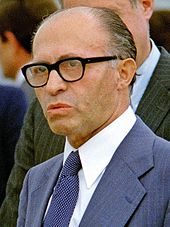
Menachem Begin, the first Israeli prime minister of the revisionist wing of Zionism
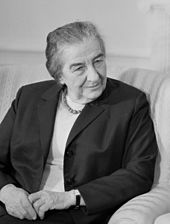
Golda Meir, Prime Minister of the country from 1969 to 1974
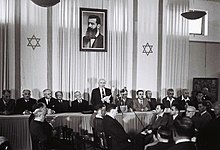
David Ben-Gurion proclaims the State of Israel on May 14, 1948
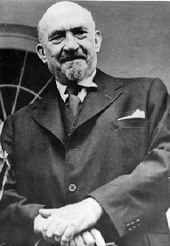
Chaim Weizmann, the first President of Israel

David and Paula Ben-Gurion
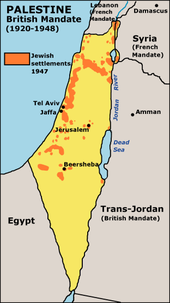
Jewish settlements from 1947

UN Partition Plan 1947

Delegate to the First World Zionist Congress in Basel, 1897

Arthur Balfour and the Balfour Declaration
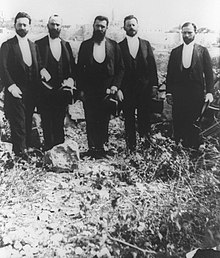
Delegation of Zionists who had come to Palestine on November 2, 1898, to meet with Kaiser Wilhelm II. From left to right: Bodenheimer, Wolffsohn, Herzl, Moses Schnirer, Joseph Seidener.
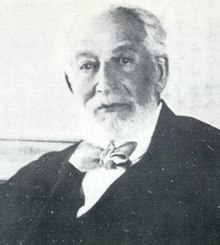
Edmond De Rothschild (1845-1934)

Max Bodenheimer memorial plaque at Richmodstraße 6 on Cologne's Neumarkt square
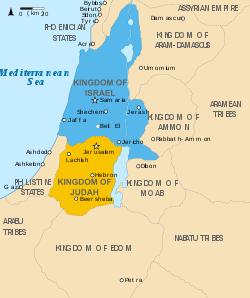
The Bible records that after the death of Solomon (around 926 B.C.), the kingdom of Israel split into the northern kingdom of Israel, ruled by Jeroboam I, with its capital in Samaria (the area colored blue), and the dominion of Rehoboam, king of Judah, around its capital in Jerusalem (the area colored ocher in the south).
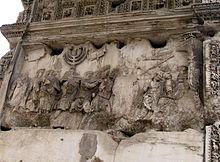
Treasures from the Jerusalem Temple, including the Menorah, are brought to Rome in the Roman Triumphal Procession after the siege and destruction of Jerusalem (depicted on the inside of the Arch of Titus in Rome).
Politics
| Political indices | ||||
| Index name | Index value | Global rank | Interpretation aid | Year |
| Democracy Index | 7.84 from 10 | 27 from 167 | Incomplete democracy | 2020 |
| Freedom in the World Index | 76 from 100 | - — | Freedom status: free | 2020 |
| Press Freedom Ranking | 30.84 from 100 | 88 from 180 | Identifiable problems for press freedom | 2020 |
| Corruption Perception Index (CPI) | 60 from 100 | 35 from 180 | 0 = very corrupt / 100 = very clean | 2020 |
Political system
→ Main article: Political system of Israel
The state of Israel is a parliamentary democracy based on the Western model. The Freedom House organization and The Economist magazine rank Israel as the only country in the Middle East to be a free democracy. In the 2019 Democracy Index of the British magazine The Economist, Israel is ranked 27th out of 167 countries, which is the best ranking among Middle Eastern states (followed by Lebanon in 108th place). Israel is considered an "incomplete democracy" according to the index.
Constitution
→ Main article: Political system of Israel#The Constitution
Israel is one of three states in the world, along with the United Kingdom and New Zealand, that does not have a codified constitution.
On June 13, 1950, the Knesset passed the Hariri Resolution, according to which a constitution was to be constructed in the form of individual "basic laws." Each basic law was to be submitted individually to parliament, and the totality of these basic laws was to be considered the "constitution" of Israel. The Declaration of Independence of May 14, 1948, and in the meantime eleven Basic Laws have replaced a constitution.
The eight basic laws passed between 1958 and 1984 deal with the institutions of the State of Israel. In 1992, they were supplemented for the first time by the Basic Laws on Freedom of Occupation and on Human Dignity and Liberty to include the protection of fundamental rights.
On July 19, 2018, the Israeli Parliament passed the Nation-State Law (officially the Basic Law: Israel - The Nation-State of the Jewish People). This enshrines Israel's claim to be the "national home of the Jewish people." Furthermore, the law designates the united Jerusalem as the capital of Israel. The flag, the national anthem, the Hebrew calendar and Jewish holidays have since been established as national symbols, and Hebrew as the sole official language. The Arabic language is granted a special status; an addition clarifies that the previous use and status of the language will not be affected by the law.
President
→ Main article: President of the State (Israel)
The President of the Republic (Nasi in Hebrew) is elected by the Knesset in a secret ballot by an absolute majority for a seven-year term. Re-election is not possible. The office of the president symbolizes the unity of the state across party-political lines. Its duties are representative and formal. Reuven Rivlin was elected president on June 10, 2014, and took office on July 24, 2014. His predecessor was Shimon Peres.
Parliament
→ Main article: Knesset
The Israeli parliament, the Knesset, was elected for the first time on January 25, 1949. The 120 members of the Knesset are elected by secret ballot for a four-year term. Israel introduced women's suffrage as early as 1946. The general election provides for closed lists, meaning that voters vote only for party lists and cannot influence the order within the lists. There are no different electoral districts; all voters vote for the same party lists. The Knesset elects the president and passes laws. The Supreme Court can only overturn a law if it violates the constitution.
Government
→ Main article: Government (Israel)
The prime minister (head of government), (Hebrew ראש הממשלה, Rosh haMemshala "head of the government") and his cabinet exercise executive power.
The president commissions the party leader, who must be a member of the Knesset, to form a new government who is most capable of doing so. After the president's selection, the chosen prime minister has 45 days to form a government, which must then be collectively approved by the Knesset. In doing so, the prime minister also outlines his government's policy.
The government is charged with conducting internal and foreign affairs. The possibilities for determining the guidelines of policy are very broad, and the prime minister is authorized to take action on any subject if this is not delegated by law to another authority.
Ministers are responsible to the Prime Minister for the performance of their duties and are required to account for their actions to the Knesset. Most ministers have a portfolio and head a ministry; others work without a portfolio but may be assigned special tasks.
At least half of the ministers must be members of the Knesset as deputies, although all ministers must be eligible candidates for the Knesset. The Prime Minister or another minister with the Prime Minister's approval appoints a maximum of six deputy ministers, all of whom must be members of the Knesset.
Until now, all governments in Israel have been formed on the basis of a coalition of different parties, since no party could muster a sufficient number of mandates in the Knesset to form a government on its own.
As a rule, the government remains in office for four years. The prime minister and the ministers of a government that leaves office continue to perform their duties until a new government takes office. If the prime minister can no longer fulfill his duties, in the event of his resignation, an indictment against him, a successful vote of no confidence by the Knesset, or his death, the government shall transfer the duties of office to one of its members who is also a member of the Knesset. This acting prime minister has full authority, except for the possibility of dissolving the Knesset.
Prime Minister since June 13, 2021, is Naftali Bennett, who replaced Benjamin Netanyahu, who has been in power since 2009.
Parties and political organizations
→ Main article: List of political parties in Israel
Israel has a multiparty system. Since the founding of the state, there have never been fewer than ten parties represented in parliament. The reasons for this are the low threshold clause and, above all, the heterogeneity of the population, which has grown through immigration.
Since the Six-Day War, the most important dividing line between the parties has been that between the "doves" and the "hawks. "Doves" advocate the principle of "land for peace." They advocate the establishment of a Palestinian state and the division of Jerusalem between Israel and Palestine. The so-called "hawks," on the other hand, advocate the "peace for peace" formula, behind which is the intention to annex all or part of the occupied territories in the long run. Traditionally, Awoda, the leading party of the "dove" camp, and Likud, the leading party of the "hawks," have opposed each other. Until 1977, all prime ministers belonged to Avoda or its predecessors; since then, there have been mostly Likud heads of government.
The largest right-wing party has traditionally been Likud, but there are also smaller right-wing parties such as Yisrael Beitenu (elected mainly by Russian immigrants). The religious parties, which distinguish between the ultra-Orthodox (Shas and United Torah Judaism) and the national religious (mainly Jamina), have mostly been allied with Likud since 1977. The largest left-wing party has traditionally been the social-democratic Awoda, with Meretz existing further to the left. Awoda and left-wing parties as a whole have lost importance. Since the end of the 1970s, centrist parties have frequently been founded, and they have often been short-lived. The most important party in the Knesset elected in 2021 is Jesch Atid (liberal, secular). New parties or alliances of existing parties are often founded before elections. In addition, there are parties that are supported predominantly (Chadash) or exclusively by Arabs and often run in different constellations with joint lists.
The strong socialist beginnings of the Israeli state explain the important role played in political life by the Histadrut, the General Confederation of Workers of Israel.
In Germany, the best-known groups of the Israeli peace movement are Gusch Schalom and Peace Now. In addition, there are several other independent human rights organizations such as B'Tselem and Machsom Watch (Checkpoint Watch), as well as the civil rights group ICAHD.
Women's suffrage
In 1920, the Yishuv created a representative assembly. This had no legal legitimacy, since power lay with the British Mandate, but the latter was required to cooperate with Jewish representatives. Ultra-Orthodox men successfully blocked women's suffrage in the Yishuv in the early days. As a compromise solution, women were given the right to vote for a limited time in April 1920. Ultra-Orthodox men were compensated by receiving two votes: one for themselves and one for their wives. There was permanent women's suffrage from 1925 in the elections to the second Legislative Assembly. However, the principle of one vote per person was not applied until the election of the fourth Legislative Assembly in August 1944. The rules applicable to this election formed the basis for the constitution of the State of Israel, which became independent on May 15, 1948. After the declaration of independence, a Constituent Assembly was to establish a constitution within five months, but this was not possible because of the war. In January 1949, Knesset elections were held according to the system that had applied to the Assembly of Representatives (see above). Then, on February 16, 1949, some basic laws were first passed by the Constituent Assembly. The provision that gender should not play a role was part of these basic laws.
Management structure
→ Main article: Administrative division of Israel
Districts
→ Main article: Districts of Israel
The territory of Israel is divided into six districts, Hebrew מחוזות mechozot (singular machoz). Almost all districts are divided into a total of 15 sub-districts, Hebrew נפות nafot (singular. nafa). In addition, official statistics include the military district of Judea and Samaria. This includes the Jewish settlements in the West Bank.
The six districts of Israel are:
- Northern District; Hebrew Mechoz haTzafon;
- Haifa district; Mechoz Cheifa in Hebrew;
- Central District; Hebrew Mechoz haMerkaz;
- District of Tel Aviv; Hebrew Mechoz Tel-Aviv;
- District of Jerusalem; Hebrew Mechoz Yerushalayim;
- Southern District; Hebrew Mechoz haDarom;
- Under military administration: Judea and Samaria; Hebrew Ezor Jehudah veSchomron.
Local government
Local government consists of three different types: city government, municipal government and regional government.
Municipality
→ Main article: Municipality (Israel)
A municipality, Iriyah in Hebrew, is the largest form of local government in Israel. Municipality status is granted by the Israeli Minister of the Interior to applying localities that normally have more than 20,000 inhabitants. Occasional exceptions are possible. In 2008, there were 71 municipalities.
Municipal administration
→ Main article: Local association (Israel)
A local council, Hebrew מועצה מקומית Mo'atzah Mekomit, English local council, hence also local association, is an administrative unit for the smaller urban settlements and the larger agricultural localities. A local council has between 2000 and 20,000 residents, placing it between cities and rural regional associations in Israel's administrative division. In 2007, there were a total of 141 municipal administrations in Israel.
Regional Administration
→ Main article: Regional association (Israel)
Regional administrations, in Hebrew מועצה אזורית Mo'atza Azorit, are the third type of local government in Israel. This is often a two-level administration.
The regional administration is responsible for several smaller settlements in rural areas, which often have their own municipal committee. The settlements are usually spread over a larger area, but in geographical proximity to each other. The individual settlements within a regional association have less than 2000 inhabitants.
The municipal committee of a settlement sends deputies to the regional administration, who are appointed directly or determined by election, in proportion to the number of inhabitants. Many kibbutzim and moshavim are part of a regional administration. In 2003, there were 53 regional associations in Israel.
Foreign and security policy
→ Main article: Foreign policy of Israel
See also: Iran-Israel relations and Iraq-Israel relations.
The goal of Israeli foreign policy is a solution to the Middle East conflict, as a result of which a long-term improvement in relations with the Arab countries is hoped for. Israel has signed peace treaties with both Egypt and Jordan. In January 2007, the Israeli newspaper Haaretz also reported that there had been secret peace negotiations with Syria between 2004 and 2006.
Another goal of Israeli security policy is the immigration of as many Jews as possible, especially those who, from Israel's point of view, are exposed to existential threats. In several spectacular actions, Israel has brought Jews to Israel, sometimes with the help of the military, even if they were not Israeli citizens, for example, the evacuation of Ethiopian Jews during the famine in their country.
The United States is Israel's most important ally and grants it the status of "important ally outside NATO." In this regard, Israel receives preferential treatment compared to Jordan and Egypt, which are also allied with the United States. This applies, for example, to access to intelligence information or arms technology.
In fact, the U.S. has a wide-ranging independent interest in the region and in Israel's continued existence. Israel, for example, is one of the states to which Congress grants the highest level of military development assistance under the so-called Foreign Military Financing program, but which is awarded on the condition that the recipient country procure military equipment exclusively from U.S. defense firms. In addition, the U.S. must approve the resale of defense equipment acquired through this financing program in each individual case.
Israel also cooperates in many areas with the PRC and especially with India. Since the 1950s, Israel has been pursuing development policy in Africa and, with less effort, in Asia. The driving forces behind this were Golda Meir and Moshe Sharet. The aim of the development policy was to break the encirclement by hostile Arab states and to weaken the unrestricted support for Arab countries by black African nations. In the case of Ethiopia, there was also an interest in ensuring the security of the Jewish minority there.
On September 7, 2010, Israel completed its accession to the OECD.
After three and a half years of construction, an approximately 400-km barrier to Egypt was completed in December 2013 to prevent illegal migrants from Africa from entering Israel and to curb drug and weapons smuggling. The construction cost was $450 million.
A peace treaty between Israel and the United Arab Emirates, also known as the Abraham Agreement, was signed by Israel's Prime Minister Benjamin Netanyahu and Emirates Foreign Minister Abdullah bin Said al-Nahjan in front of the White House in Washington at 1:37 p.m. Tuesday, Sept. 15, 2020, in the presence of U.S. President Trump. At the same time, a peace treaty between Israel and Bahrain was signed with the Kingdom of Bahrain by Abdullatif bin Rashid al-Sajani, as well as with Morocco and Sudan. However, recognition of Israel's right to exist by other Arab states has so far failed to materialize.
Israel and Kosovo agreed to establish diplomatic relations on February 1, 2021. The agreement marks another country with a majority Muslim population recognizing Israel. Kosovo is also the first European country to open its embassy in Israel's capital, Jerusalem. So far, only the United States and Guatemala have moved their diplomatic missions from Tel Aviv to Jerusalem. However, the European Union's foreign policy spokesman, Peter Stano, threatened that Kosovo would forfeit its prospects for EU membership by deciding to open an embassy, but this does not deter Kosovo. Equatorial Guinea also wants to move its embassy in Israel to Jerusalem.
Israeli peace diplomacy
→ Main article: Israeli peace diplomacy
Both early Zionist representatives before Israel's independence and several Israeli government leaders afterward have reached several agreements with Arab representatives since 1919 and presented a variety of peace offers, but for a variety of reasons, none of these were able to establish a regional peace. These peace offers were intended to definitively resolve the key conflict issues in the Israeli-Palestinian and Israeli-Arab talks-borders, Israeli settlements, security, and refugees.
These offers included, among others, the peace offer to Syria and Egypt presented nine days after Israel's victory in the Six-Day War, which was mediated through American diplomatic channels and offered the return of the Golan Heights to Syria and the return of the Sinai to Egypt in return for a peace treaty. However, the Arab League, through the Khartoum Resolution, categorically rejected any negotiations with Israel (No peace with Israel, no recognition of Israel, and no negotiations with Israel). Furthermore, from 1967 to 1970, the Allon Plan offered the return of up to 98% of the West Bank to Jordan, but King Hussein I rejected this.
Other important events were the handover of 40% of the West Bank, with over 90% of the population, to the Palestinian Authority in the course of the Oslo peace process and Israel's agreement to the Clinton Parameters. These provided for a future Palestinian state in all of Gaza and up to 97% of the West Bank. In addition, in 2005, Israel ceded all of Gaza to the Palestinian Authority under the "Sharon Plan" and in 2008 offered a territorial solution to the disputed areas of the West Bank that would allow for a Palestinian state in the West Bank through a mutual exchange of territory (see figure). However, this proposal was rejected by Mahmoud Abbas.
Military
→ Main article: Israel Defense Forces
The Israel Defense Forces (Hebrew צבא ההגנה לישראל Tzwa haHagana leJisra'el, abbreviated צה "ל Tzahal, or in English Israel Defense Forces, abbreviated IDF) are considered the strongest armed forces in the region. Personnel strength and the number of weapons systems are subject to secrecy. Estimates put the number of personnel at around 176,500 men and women (including 133,000 in the army, 34,000 in the air force and 9500 in the navy), which can be increased to more than 600,000 in the event of a defense strike. The military threat to Israel has changed since the end of the Cold War from symmetrically aligned adversaries to asymmetrically fighting Palestinian and Lebanese organizations.
Israel has a compulsory military service of 36 months for men and 24 months for women, from which Israeli Arabs and all non-Jewish, pregnant or married women are exempt. Only women are permitted to avoid conscription for reasons of conscience; they then perform alternative civilian service of one to two years. The monthly salary of conscripts is about 460 NIS (about 98 euros). Conscientious objection can result in imprisonment.
A characteristic of the Israeli military system is the comparatively high level of international involvement of its reservists, who maintain a high level of training and serviceability due to regular reserve service (one month per year for non-commissioned officers and enlisted men until the age of 42 and 51 for officers, and until the age of 24 for women). The armed forces also conduct regular exercises in cooperation with the United States and other NATO countries and frequently send their junior leaders to these countries for training.
The backbone of the army is the tank force with around 1500 modern Merkava main battle tanks. In addition, some 2,000 older models, mainly M60s (Magach), are still in service, mainly with reserve units. The air force has about 500 combat aircraft and 200 helicopters; although these are almost exclusively of U.S. production, they were often modified by Israeli defense companies during construction or subsequently to meet the specific requirements of the Israeli armed forces and are generally armed (such as Delilah, Nimrod and Spice) and equipped with electronics (such as Litening) of Israeli production. The Israeli Navy has, among other things, some 40 patrol boats, ten missile boats, three corvettes and four modern Dolphin-class submarines. The German defense industry is involved in the development and delivery of the Dolphin submarines. In addition, the engine of the Merkava IV tank was developed by MTU Friedrichshafen and is produced under license by L-3 Communication Combat Propulsion Systems (formerly General Dynamics). In return, Germany was supplied with the Israeli-designed Spike anti-tank missiles. The Bundeswehr also operates the Israeli Heron drones.
The Israeli infantry has various weapons at its disposal. Most commonly used is the American M16 (rifle) in various versions. However, Israeli-made weapons are also in use, such as IMI Negev, Tavor TAR-21, IMI Galatz, IMI Galil, Uzi and Baby Eagle.
Israeli defense companies include: Israel Weapon Industries, Israel Aerospace Industries, Rafael and IMI.
For air defense, Israel has had the Patriot air defense system (PAC 2 version) since 1991 and the Hawk air defense system since the 1960s.
Israel has had the Arrow (original Hebrew name: חץ; "Chetz") missile defense system (Arrow 2 version) against medium-range and intercontinental ballistic missiles since 2000, but for a long time had no means of defense against the firing of Kassam rockets, which Hamas uses from the Gaza Strip, and Hezbollah's Katyusha rockets from southern Lebanon due to their short range with corresponding flight time. The Iron Dome defense system (original Hebrew name: כיפת ברזל kipat barzel, German 'Iron Dome') was developed to counter the threat of missiles with a range of up to 70 kilometers. The first batteries were put into operation near Be'er Sheva in March 2011 and were already able to intercept Hamas rockets shortly thereafter. The David's Sling defense system is also planned against missiles with a range of between 70 and 250 kilometers. To increase protection against ballistic missiles, the improved PAC 3 version of the Patriot air defense system has recently been deployed and an improved version of Arrow (Arrow 3) is under development.
Israel has never signed the Nuclear Non-Proliferation Treaty and is widely believed to have had nuclear weapons developed at the Negev Nuclear Research Center since the 1960s. In the 1970s, there was secret joint nuclear weapons research with South Africa. Experts believe that Israel has about 200 nuclear warheads. Israeli nuclear technician Mordechai Vanunu published quite a few glimpses of Israel's nuclear weapons program, for which he was indicted and convicted. The official policy of the government is not to comment on this issue, i.e., neither to admit nor deny possession (the so-called policy of "nuclear ambiguity"). A December 2006 interview in which Prime Minister Ehud Olmert named Israel in addition to France, the United States, and Russia in a list of nuclear weapons powers was interpreted by the international press as an indirect admission of Israeli possession of nuclear weapons and at the same time as a threat and replica in the direction of Iran. On December 4, 2012, the UN General Assembly passed a resolution by a vote of 174 to 6 that Israel immediately accede to the Nuclear Non-Proliferation Treaty and allow the IAEA into the country to inspect its nuclear facilities.
Israel ranked first in the Global Militarization Index (GMI) in 2017. Israel spent just under 4.7 percent of its economic output, or $16.5 billion, on its armed forces in 2017.
Police
→ Main article: Police (Israel)
The Israel Police (Hebrew: משטרת ישראל, Mishteret Yisrael) employs around 30,000 full-time forces. These are supported by 33,000 volunteer forces (as of 2016). The police's duties include law enforcement, controlling road traffic and averting threats to public order and security. It is under the authority of the Ministry of Public Security of Israel and was established in 1948. The emergency telephone number is 100.
The regional structure corresponds to the six districts of Israel. The functional structure is based on the areas of responsibility in numerous departments, such as Investigations & Intelligence or Policing and Security.
In addition, there is the Border Police (Hebrew מִשְׁמַר הַגְּבוּל Mishmar HaGvul or מג״ב Magav for short), which maintains several special counterterrorism units, including JAMAM.
The head of the police (Nitzav or Rav Nitzav) is appointed by the Israeli government on the recommendation of the Minister of Internal Security. He is assisted by a deputy.
Intelligence Services
→ Main article: Mossad
The Mossad (המוסד למודיעין ולתפקידים מיוחדים, "Institute for Reconnaissance and Special Tasks"; actually Mosad Merkazi leModi'in uLeTafkidim Mejuchadim, "General Intelligence and Security Service") is Israel's foreign intelligence service.
In addition to it, there is the domestic intelligence service Shin Bet and the military intelligence service Aman.
Settlement Policy
→ Main article: Israeli settlement
In the territories occupied since June 1967, more than 400 Jewish settlements and so-called outposts have been established, inhabited by Jewish Israelis. The number of Jewish Israeli settlers totals nearly 600,000, of whom approximately 391,000 live in the West Bank (as of 2016) and 201,200 in East Jerusalem (as of 2014). In Gaza, about 7500 Israelis lived among more than one million Palestinians as of August 2005. The settlements are often generously built along U.S. lines. They are protected against attack by a massive security apparatus. A network of special roads, some of which may only be used by Israeli citizens, provides a good transportation infrastructure between the settlements and Israeli territory. At the same time, it makes development in the Palestinian autonomous areas more difficult. The freedom of movement of the Palestinian population is further restricted by Israeli roadblocks and checkpoints.
In August 2005, the Sharon government, in close coalition with the Labor Party, evacuated all settlements in the Gaza Strip and four smaller settlements in the West Bank. This was a unilateral and globally recognized step by Israel, which was not developed within the framework of the "road map" (see Sharon Plan). However, there was also talk from Sharon's circle that the aim was to expand the largest settlements in the West Bank. In return, territorial concessions are to be made to the Palestinians. Militant Palestinian organizations portray this partial Israeli withdrawal as their own victory over Israel. Ariel Sharon's successor in office, Ehud Olmert, has offered the Palestinians, through his so-called Convergence Plan, to accept a Palestinian state in exchange for fixing the course of the barrier currently built beyond the Green Line in Palestinian territory.
Internationally, Jewish communities and settlements in the occupied Palestinian territories are predominantly regarded as contrary to international law. International law permits the temporary confiscation of land in occupied territories solely for military purposes, but not for the permanent settlement of its own citizens, agriculture, or other civilian uses. Israel has a different assessment of the legal situation, but stands isolated internationally as a result. In several resolutions, the United Nations has called on Israel in vain to stop settlement construction.
Law
→ Main article: Law of Israel
The law of modern Israel has its origins in three different legal traditions: The law of Ottoman times, the law of the British Mandate period in the form of common law, and the positive law of the Israeli legislature since 1948.
The establishment of the State of Israel in 1948 did not initially bring any far-reaching changes: The Law and Administration Ordinance 1948 left all existing law in force unless amended by new legislative acts. To the present day, therefore, much of Israel's law in the area of commercial and corporate law is substantively English law, even though since 1972 the jurisdiction of the English courts is no longer binding. Ottoman law is still relevant in only a few areas, as the Israeli legislature has reorganized contract and property law in particular. In the long term, the current private law is to be transferred to the order of the continental European legal system in the form of a civil code. English law is thus giving way more and more to independent Israeli jurisprudence, which is nevertheless methodologically close to common law.
Legal system
The Israeli legal system consists of laws enacted by the Knesset and, to some extent, ordinances issued by the British Mandate until 1948, which in turn were adopted and revised in detail by the Knesset. The Israeli legal system can best be characterized as a "mixed" system, since it belongs to the Western legal systems, has been heavily influenced by Anglo-American law, but also contains aspects typical of Roman-style civil law. In addition, certain features of the legal system are influenced by the fact that Israel is a Jewish state. The Supreme Court's rights in the legal evaluation of the Knesset's laws are limited. Judicial interpretation is limited to formal problems such as the execution of laws and the validity of subordinate legislation.
In December 1985, Israel informed the UN Secretariat that the peremptory jurisdiction of the International Court of Justice would no longer be accepted.
Judiciary
The independence of the judiciary, divided into secular and religious courts, is guaranteed by the basic laws.
Judges of secular courts are appointed by the president on the recommendation of a special nomination committee composed of Supreme Court justices, members of the bar, and public figures. Judges are appointed for life and take mandatory retirement at age 70.
The secular judiciary is divided into three tiers: At the first and second levels, there are magistrate and district courts for civil and criminal trials, as well as juvenile, traffic, military, labor and municipal appellate courts.
At the head of the judiciary, as the highest appellate authority, is the Supreme Court, with its seat in Jerusalem. The judges of the Supreme Court also form the "High Court of Justice" ("Beit-Din Gawoah LeTzedek" = "BaGaTz"), which has three, five or seven judges, depending on the importance of the case. This court is the sole and highest appellate instance in matters of principle and (similar to the German Constitutional Court) offers the possibility of bringing an action against the government as well as all representatives and institutions of the state and having their measures reviewed for legality, even suspending them if necessary.
According to Ottoman legal tradition, matters of personal status, such as marriage and divorce, alimony, guardianship and adoption of minors, fall under the jurisdiction or administration of the respective religious community. These religious courts are the rabbinical courts for the Jewish religious communities, the Muslim Sharia courts, the religious courts of the Druze, and the ecclesiastical courts of the ten recognized Christian communities in Israel. Several hundred non-religious or mixed-religious couples must therefore travel abroad each year to marry and then have their marriages recognized in Israel. For partners who do not belong to any religious community, there is now a legal institution similar to civil marriage; several legislative initiatives to introduce civil marriage have failed in recent years due to opposition from the Orthodox parties.
Although the legislative branch is exclusively within the purview of the Knesset, the Supreme Court has the ability to call attention to desired changes in the law; as the Supreme Court, the court has the authority to decide whether a law is consistent with the basic laws of the state.
Human Rights
Israel has strong and independent institutions that guarantee political rights and civil liberties for most of the population. Freedom House therefore classifies Israel as "free.
Amnesty International reported in late 2011 that Israel had displaced more than 1,000 Palestinians and destroyed more than 500 houses, apartments, and water supply installations in the West Bank, including East Jerusalem, this year, doubling the previous year's displacement and destruction. He said this trend was accompanied by an increase in Israeli settlement construction and violent attacks by settlers on Palestinians.
After Israel had long accused the UN Human Rights Council of being one-sided in its criticism of Israel and therefore boycotted it, there were signs of a turnaround in 2013. In June 2018, however, Israel welcomed the U.S. withdrawal from the Human Rights Council. Head of government Benjamin Netanyahu accused the Council of focusing obsessively on Israel.
In July 2020, the Israeli human rights organization Yesh Din accused the Israeli government of apartheid in the occupied territories. In January 2021, the Israeli human rights organization B'Tselem called Israel an apartheid regime. In April 2021, Human Rights Watch accused the Israeli government of apartheid and other crimes against humanity in Gaza, the West Bank, and East Jerusalem. Similar accusations had been made in the past.
Torture
Until 1999, torture of Palestinian prisoners by Israeli security forces was widespread and systematic. In 1999, Israel's Supreme Court ruled that prisoners could no longer be tortured during interrogations.
Attorney General Elyakim Rubinstein, however, issued a decree stating that intelligence officers who nonetheless tortured detainees would not stand trial if they could prove that it was "immediately necessary to preserve life, freedom of people or property from a concrete danger of serious harm" and that there was "no other way to ensure this." High-level officials had to approve the methods, and interrogators had to keep detailed records of the number of beatings, painful forced positions, and any other so-called special means. In the 2000s, there were about a thousand complaints of torture against the intelligence service, all of which were dismissed by the authorities; court cases were not allowed. In 2014, the number of cases of torture by the Israeli intelligence service rose sharply again.
In November 2018, the Supreme Court (Judges Yosef Elron, Isaac Amit, and David Mintz) dismissed a lawsuit against the intelligence service for torture, ruling that the "special interrogation methods" used by the intelligence service against plaintiff Firas Tbeish - sleep deprivation, beatings, painful positions, violent shaking until unconsciousness - were justified as an exception as described in the 1999 court ruling. Judge Mintz referred to this as a "ruling that torture is prohibited except in highly exceptional circumstances."
In September 2019, Palestinian Samir Arbid was arrested and tortured nearly to death by Shin Bet operatives. After being tortured by the Shin Bet, Arbid was taken to a hospital in critical condition, unconscious, with countless broken bones and trauma, as well as kidney failure and a suspected heart attack, and had to be ventilated. Judicial bodies had authorized Arbid's torture. Israeli authorities launched an investigation when the abuses became known, but in January 2021 Attorney General Avichai Mendelblit closed the investigation against the torturers.
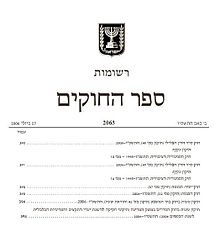
Page with some of the first Israeli laws

The building of the Supreme Court

Israeli settlements in the West Bank occupied since 1967
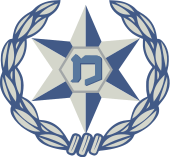
Israel police emblem
.jpg)
Female soldiers of the Karakal battalion
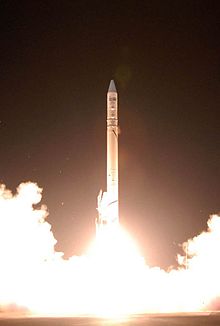
Shavit at launch - a launch vehicle developed from the Jericho-2 medium-range rocket.
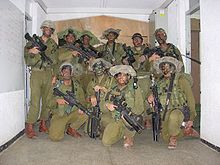
Soldiers of the Netzach Yehuda Battalion
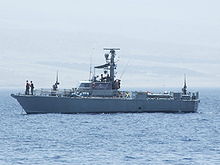
Dabur-class patrol boat at sea.
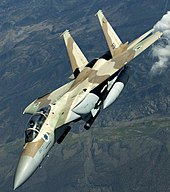
Israeli F-15 I Ra'am, a variant of the McDonnell Douglas F-15E Strike Eagle suitable as a nuclear weapons carrier.
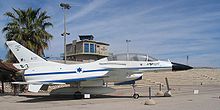
IAI Lavi of Israeli production- a representation of Israeli defense technology.

F-16I 'Sufa
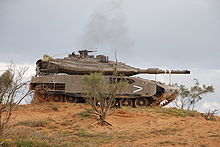
The Merkava 4, Israel's most advanced main battle tank

States with embassies from Israel

States that have embassies in Israel
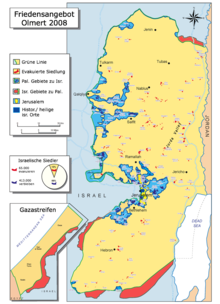
Peace offer presented by former Israeli Prime Minister Ehud Olmert with a solution to the settlement problem through a territorial exchange to create a sovereign state of Palestine in territory equivalent to the size of the West Bank and Gaza Strip.
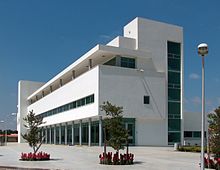
The office of the regional association Menashe
,_administrative_divisions_-_de_-_colored.svg.png)
Map of districts in the state of Israel
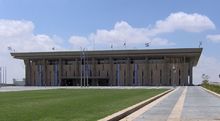
The Knesset, the Israeli parliament building

Meeting room in the presidential palace in Jerusalem
Economy
→ Main article: Economy of Israel
General
Israel has a technologically highly developed market economy with a high state share. Therefore, the public sector is also an important employer, employing 33 % of the Israeli workforce. Industry employs 17 %, tourism, trade and finance 20 %; 28 % work in other sectors (services, etc.).
In 2016, the national budget comprised expenditures of the equivalent of 88.7 billion U.S. dollars, which were offset by revenues of the equivalent of 80.7 billion U.S. dollars. This resulted in a budget deficit of 2.4% of GDP.
The national debt in 2016 was $121.1 billion, or 62.0% of GDP. In recent years
, Israel has been successful in restructuring its national budget.
In 2006, the share of government spending (as a % of GDP) of the following areas was:
- Health: 8.0 %
- Education: 5.9 % (2009)
- Military: 7.4 % (2012)
About half of Israel's public foreign debt is owed to the United States, its main source of political, economic, and military support. A relatively large share of Israel's foreign debt is held in the form of State of Israel Bonds by private investors. The combination of U.S. loan guarantees and direct borrowing from private investors allows Israel to borrow at favorable rates, sometimes below market rates. This policy is also tolerated and supported by Germany in order to achieve the strategic goal of securing the existence of the Jewish state.
In 2015, economic growth was an estimated 2.4%, below the previous year's growth of 2.8%. Israel's gross domestic product totaled $305 billion in 2014, and gross domestic product per capita was $37,731 in the same year. Unemployment was approximately 5.4% in 2015. In 2017, it was 4.3%. The total number of employed people is estimated at 4 million in 2017, of which 47.2% were women. In the Global Competitiveness Index, which measures a country's competitiveness, Israel ranked 16th out of 137 countries (as of 2017-2018). In the Economic Freedom Index, Israel ranked 36th out of 180 countries in 2017.
Israel is dependent on imports for fossil fuels (crude oil, natural gas, coal), grain, beef, raw materials and military equipment. There are small amounts of petroleum, phosphates, potash, and kaolin in the country. It is unknown whether Israel has precious metals and gemstones as other mineral resources. However, large gold deposits are suspected. In the case of natural gas, there are signs of a change in dependence on imports since four deposits were discovered off the Mediterranean coast. Since 2014, Israel has been producing natural gas from the Tamar gas field, which is located about 90 kilometers off the coast of Haifa, and this gas is then piped to the southern Israeli city of Ashdod for further processing. In the medium term, natural gas is also to be exported to Europe as liquefied gas in cooperation with Cyprus.
Not least because of its limited resources of arable land, water and raw materials, Israel has intensively developed its agricultural and industrial sector in recent decades. Nevertheless, Israel is not an agricultural self-supplier. Feed grains, in particular, must be imported for the most part. Israel has significant capacities in petroleum refineries, diamond cutting plants and in the fabrication of semiconductors. Significant exports include polished diamonds, advanced technology, military equipment, software, pharmaceuticals, fine chemicals, and agricultural products (fruits, vegetables, and flowers, and more recently caviar). Israel invests more money per capita in research and development than any other country. A Silicon Wadi has developed in the Tel Aviv region, with 422 startups in the first nine months of 2011 alone. The innovative Israeli startup scene in the field of cutting-edge technologies is considered exemplary worldwide.
One major problem is water supply. With additionally developed novel methods for economical land irrigation (see section on science and technology), attempts are being made to overcome the water shortage. Water supply is also a political bone of contention that has led to tensions with neighboring Syria in the past.
Influence of immigration
Immigration from the former Soviet Union brought scientists and academics to the country who are of considerable value to Israel's future. The influx, combined with the opening of new markets after the end of the Cold War, revitalized Israel's economy and ensured rapid growth during the 1990s. When the government adopted tighter fiscal and monetary policies beginning in 1996 and the influx of immigrants slowed, growth began to slow. On the other hand, inflation fell to a record minimum in 1999.
Social situation
According to a 2008 report by the National Insurance Institute (המוסד לביטוח לאומי), poverty in Israel continues to increase, despite the fact that per capita gross domestic product increased by 12.4% between 2004 and 2006 alone. In 2007, 24.7% of the total population and 35.9% of children lived below the poverty line in Israel excluding the territories occupied in 1967. The high level of poverty among children is a record among developed countries.
The poverty line in 2007, according to Israeli definitions, was a monthly income of 2028 shekels (about 364 euros) for a single person, 3244 shekels (600 euros) for a childless couple, and 5191 shekels (944 euros) for a family of four.
The so-called working poor are a major problem due to the extremely low wages in many sectors: 40% of all households below the poverty line have at least one working person.
In the summer of 2011, the unsatisfactory social situation in Israel led to the largest protest actions in recent history. Up to half a million people demonstrated, mainly in Tel Aviv, against the high cost of living and demanded social justice and a welfare state.
See also: Protests in Israel 2011/2012
According to the December 2015 National Social Security report, 31% of Israel's children are currently growing up in poverty. This means that there has been a slight improvement in the situation in recent years. Overall, however, 22% of Israelis are still considered poor. According to the report, the poverty rate is particularly high among ultra-Orthodox Jews and among the country's Arab minority of Palestinians. Here it is around 50% in each case.
Workweek
The official work week in Israel begins with Sunday (Hebrew "Yom Rishon," "First Day") as the first day of the week. During the Sabbath, from Friday afternoon to Saturday evening, most businesses remain closed and almost no services are offered. Here, however, there are strong differences between more religiously and more secularly influenced localities.
Tourism
→ Main article: Tourism in Israel
Tourism in Israel is an important economic factor in the country. The Ministry of Tourism is responsible for this.
Many destinations in Israel are sites of Christianity such as the Old City of Jerusalem, Nazareth, Bethlehem and the Sea of Galilee. There are also numerous historical sites, such as the cities of Caesarea Maritima, Beth She'an and Acre, the fortress of Masada, and a section of the former Spice Route from Petra to Gaza. Bathing vacations are possible on the Mediterranean coast, the Red Sea and the Dead Sea. There are also diving areas and resorts on the Red Sea (Eilat). There are also nine UNESCO World Heritage sites in Israel. Due to the very good transportation infrastructure, individual travel can be easily accomplished.
The place with the highest number of tourists is Jerusalem with about 3.5 million visitors annually. Tel Aviv was visited by 1.676 million tourists. Origin of tourists by highest number (first): United States, Russia, France and United Kingdom. In 2008, the Israeli government allocated 10 million shekels (about €2.077 million) for tourism promotion in Europe.
Most tourists arrive from Ben Gurion Airport near Tel Aviv. Entry problems arise when tourists' passports have visas or entry stamps from Arab countries (except Jordan and Egypt).
Banks
Israel's banking system has its roots in the Zionist movement in the early 20th century before the establishment of Israel. The World Zionist Organization with Theodor Herzl established the Anglo Palestine Company (APC) (later renamed Bank Leumi) on February 27, 1902. Israel's three largest banks are Hapoalim, Leumi and Israel Discount Bank, which account for over 60% of Israel's banking industry. All of the state's banks are supervised by the Central Bank of Israel.
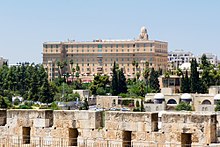
The King David Hotel, Jerusalem
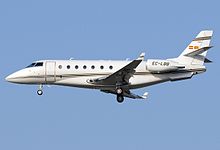
The Gulfstream G200 - a transcontinental business jet developed by Israel Aerospace Industries.
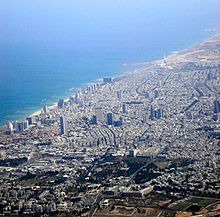
An aerial view of the Tel Aviv conurbation
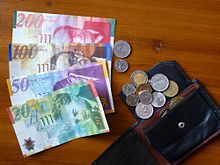
New Israeli shekel banknotes and coins
Infrastructure
Road traffic
The most important mode of transport is the road. Israel has a total of 18,096 km of paved roads and 2.4 million motor vehicles. The number of motor vehicles per 1000 people is 324, which is relatively low compared to other industrialized countries. In Israel, 5715 buses are active in regular service. Of particular importance are the intercity buses of the Egged bus cooperative.
Rail transport
Of increasing importance is the rail network of Israel Railways, which has been modernized and expanded for several years after decades of neglect. The route network of the state-owned Israel Railways amounts to 949 km. Following major investments in the 1990s, the number of passengers per year has increased from 2.5 million (1995) to 35 million (2008). The railroads also transport around 6.8 million tons of freight per year.
A streetcar line has been operating in Jerusalem since 2011. An extensive streetcar network is being prepared for Tel Aviv. A first line is already under construction.
Air traffic
The most important airport is Ben Gurion Airport near Lod in the greater Tel Aviv area. It had 14.9 million passengers in 2014. Other airports: Sde-Dov Airport in the city of Tel Aviv, Haifa Airport, Eilat Airport, the new Ramon Airport a few km north of Eilat, Rosh Pina Airport. Atarot airport in Jerusalem has been out of service since 2001. The largest airline is El Al, based at Ben Gurion Airport, which currently serves 44 destinations worldwide. Air traffic to and from Israel is subject to particularly strict security regulations due to the constant terrorist threat.
Seafaring
Haifa, Ashdod and Eilat are the three port cities of the country. The port of Haifa, located on the Mediterranean coast, is the oldest and largest port in the country, while the port in Ashdod is one of the few deep-water ports in the world and was built on the open sea. In addition, there is a port in Eilat, this is used for trade with the countries of the Far East. There are also smaller ports in Chadera, Tel Aviv and Ashkelon, but they only supply coal, natural gas or oil for nearby electric power plants. There are marinas in Ashkelon, Ashdod, Tel Aviv, Herzlia, Haifa and Eilat. Cruise ships occasionally dock in Haifa, Ashdod, and Eilat. Seasonal ferry services to Cyprus and on to Greece operate only from Haifa.
Border crossings
Israel is accessible via land borders only from Jordan and Egypt. The border with Syria and Lebanon is closed to civilians.
The official border crossings with Jordan are:
- the Sheikh Hussein Bridge over the Jordan River at Bet She'an
- the Allenby Bridge over the Jordan River near Jericho (West Bank)
- the Arava crossing near Eilat and Aqaba
The official border crossings with Egypt are:
- the Kerem-Shalom crossing near the Gaza Strip
- the Nizanna crossing
- the Netafim crossing north of Eilat
- the Taba crossing south of Eilat.
Since the withdrawal from Gaza, the Karni and Erez crossings have been considered de facto border posts (de jure status to be determined). The Rafah crossing, between the Gaza Strip and Egypt, is no longer managed by the Israelis.
Telecommunications
The last mile for telephone lines and ADSL is provided by Bezeq. Around 2003, Hot also began offering telephone and Internet via the TV cable network. In 2016, 78.9 percent of the population used the Internet. The IT industry in Israel is among the most competitive in the world.

Duty-free at Ben Gurion Airport
Education
The administration and financing of the Israeli education system is carried out by the Ministry of Education, the Ministry of Science, Culture and Sports, and the cities.
Schools and universities
In Israel, school attendance is compulsory for children between the ages of five and sixteen. School attendance is free until the age of 18. As a rule, three- to four-year-olds attend a kindergarten for which a fee is charged. In Israel, median school attendance increased from 10.8 years in 1990 to 12.8 years in 2015. It is thus one of the highest in the world.
The school system is adapted to the multicultural population. There are different state schools whose curriculum is adapted to specific aspects, such as the language and religion of the students. The smaller part of Israeli students attend private schools that operate under the auspices of religious and international organizations.
In 2018, spending per elementary student in government Hebrew schools was 15,300 shekels, in government religious schools 19,300 shekels, and in official Arab schools 16,900 shekels.
In 2019, per-pupil spending per year in "regular" Jewish middle schools was 32,800 shekels, in government religious middle schools it was 43,100 shekels, and in government Arab middle schools it was 26,800 shekels, meaning that per-pupil spending in religious Jewish schools was 61 percent higher than that in Arab schools, and that in "regular" Jewish middle schools was 22 percent higher.
In high school, students can choose between an academic, technological, agricultural or military specialization. After passing the final examination, one receives the bagrut.
About 216,000 students are enrolled in one of the country's higher education institutions. World-renowned are the Technion and the Hebrew University of Jerusalem. Israel's eight universities offer a wide range of courses in natural sciences and humanities, see List of Universities in Israel.
In addition, a large number of academic colleges exist that do not have university status, but may issue recognized academic diplomas and often cooperate with universities, see List of Academic Colleges in Israel.
Tens of thousands take advantage of adult education programs. Special language schools are available for new immigrants, offering intensive Hebrew courses.
Librarianship
Israel's library system has had a turbulent history. It developed increasingly under immigration of German book experts after 1933. The first director of the Jewish National and University Library was Hugo Shmuel Bergmann, who had formerly worked at the German-speaking Charles University in Prague. Bergmann built up the collections accordingly and commissioned specialists for the individual areas. For the Hebraica collection, he was able to recruit the young Gershom Scholem. The second director was also a German, Gotthold Weil, who had lost his position at the Prussian State Library in Berlin. From 1949, the position was taken over by Curt Wormann, also from Germany. He left a lasting mark on the Israeli library system, but was criticized for being too inflexible in responding to the needs of new immigrants and the demands of mass immigration after the founding of the state. However, a distinction should be made between individual libraries and their purpose. In the case of Tel Aviv's municipal libraries, intended for the public, this may be true, but the National and University Library had to conform to international academic standards.
A deposit copy law has existed since 1953; in 2001, the regulation was renewed and extended from books, magazines and newspapers to audiovisual media; network resources are still excluded. The deposit copy law stipulates the delivery to a total of five institutions. These are the State Archives, the Knesseth Library, the Ministry of Education, and the National Library of Israel, which receives two copies. The Israeli Center for Libraries (ICL) publishes an annual catalog of registered periodicals on CD-ROM and as an online version. To date, around 4800 ISSNs have been issued in Israel. The Israeli state has a dense network of libraries in large cities as well as in the countryside.
Science and technology
In the years from 2002 to 2013, the Nobel Prize was awarded to eight Israelis in scientific fields:
- Michael Levitt, Chemistry, 2013
- Arieh Warshel, Chemistry, 2013
- Dan Shechtman, Chemistry, 2011
- Ada Yonath, Chemistry, 2009
- Robert Aumann, born in Germany, Economics, 2005
- Aaron Ciechanover, Chemistry, 2004
- Avram Hershko, born in Hungary, Chemistry, 2004
- Daniel Kahneman, Economics, 2002
The need to transform a relatively barren, underdeveloped land into the modern industrial state it is today has been a determining factor in Israel's scientific and technological development since its founding. Water scarcity, desert landscape, and labor shortages also led to the development of novel agricultural methods.
Today, Israel invests an above-average amount in research and development compared to the rest of the world. The universities, which work closely with industry, produce 80 % of the research results. Universities even set up companies to market the practical applications of their research results. More than half of all scientific publications are in biotechnology, biomedicine and clinical research.
Israeli scientists were instrumental in researching the messenger substance interferon. Pharmaceutical research also often benefits from Israeli capacities, for example in the development of the drug Copaxone. Highly sophisticated medical diagnostic and treatment equipment is developed in Israel and exported worldwide. Among them are devices for computer tomography and magnetic resonance imaging, ultrasound scanners, nuclear medicine cameras, surgical lasers, and a miniature camera used as a swallowable capsule to examine the digestive tract.
A major focus of Israeli research is electronics and communications technology. Israel is one of the leading countries in the research and development of optical fibers, electro-optical control systems and heat-sensitive night vision devices. In addition to software for mainframe and office computers, robots are being developed for a wide variety of applications.
The Israel Space Agency was founded in 1983. Since 1988, Israel has been able to launch satellites into space using its own rocket (Shavit). In addition, various display systems, aeronautical computers, instruments and flight simulators have been developed. Ilan Ramon was the first Israeli in space within the STS-107 mission in 2003. He and his six NASA colleagues suffered a fatal accident during re-entry of the Space Shuttle Columbia.
The scarcity of water drove the development of computer-controlled irrigation systems. It was in this context that the drip method was developed, in which water is piped directly to the roots of the plants. Intensive research has made it possible to harness the vast underground reservoir of brackish water beneath the Negev: Various plants such as cherry tomatoes thrive on this water, which is pumped up from a depth of a thousand meters and has a temperature of 42 degrees Celsius.
After a severe supply crisis in 2008, the water industry was radically modernized. Leaks in water pipes are systematically combated with high-tech (Aquarius detector). With the latest technology, highly effective management and collective effort, water shortages in Israel are now a thing of the past.
| Desalination plants in Israel | ||
| Location | Commissioning | Output |
| Ashkelon | 2005 | 118 |
| Palmachim | 2007 | 090 |
| Chadera | 2009 | 127 |
| Sorek | 2013 | 150 |
| Ashdod | 2015 | 100 |
| Source: IsraelNet 4/19 | ||
As of 2017, five seawater desalination stations are in operation. They cover over 70 percent of the country's water needs. Technical improvement has made the desalination process much more energy efficient and, above all, cheaper. A cubic meter of ready-to-drink tap water is obtained for under 50 ct. Beyond domestic consumption, Israel supplied 79 million cubic meters of drinking water to the Palestinian National Authority and 52 million cubic meters to Jordan.
World record for water recycling: 86 percent of wastewater from households is used for agriculture. For comparison: USA, 1 percent. The annual per capita consumption (as of 2016, total, incl. all sectors) of 280 cubic meters is very low by international standards (USA 1540 m³).
In 2017, a tunnel project was started to bring water from the desalination plant (reverse osmosis plant) near Tel Aviv into Jerusalem. 4 meters in diameter, 13.5 kilometers long and 125 meters under massive mountain rock. With a transport capacity of 65,000 cubic meters per hour.
The unavailability of conventional energy sources necessitated the intensive development of alternative energy sources such as solar, thermal and wind energy. Israel does not operate a nuclear power plant because it does not want to allow its nuclear facilities to be monitored by the International Atomic Energy Agency (IAEA). Since 2007, it has been planning to build a 2000-megawatt reactor in the Negev Desert, where the Negev Nuclear Research Center is located near Dimona.
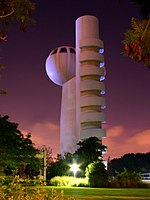
Particle accelerator at the Weizmann Institute of Science, Rehovot
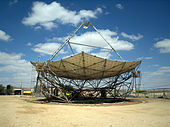
The world's largest solar parabolic reflector at the Ben-Gurion National Solar Energy Center in the Negev Desert

Dan Shechtman received the Nobel Prize in Chemistry in 2011
Questions and Answers
Q: What is the population of Israel?
A: The population of Israel was 8.1 million people in 2013 and 6.04 million are Jewish.
Q: What is the capital city of Israel?
A: The capital city of Israel is Jerusalem (limited recognition). Most countries keep embassies in Tel Aviv.
Q: What type of climate does Israel have?
A: The climate in Israel is hot and rainless in the summers with high humidity in the coastal plain and lower elevations, and cool and rainy in the winters, rarely going below freezing temperatures.
Q: Does Israel have natural resources?
A: Israel has few natural resources and imports more goods than it exports.
Q: How educated are its citizens?
A: Almost all of its people can read and write.
Q: Is it a democratic republic?
A: According to the Democratic Index, Israel is the only democratic republic in the Middle East. According to Freedom House, it is also the only full democracy in the Middle East.
Q: What kind of history does it have with Palestine?
A: It has a long history of conflict with Palestine.
Search within the encyclopedia